Green Buildings and Environmental Sustainability Analytical Essay
Introduction, environmental impacts, efficiency of materials, energy efficiency, water efficiency, pay offs and costs, works cited.
With the increasing concern of human activities on global warming, there has been an incredible attention on looking for mechanisms of reducing its impacts on the environment. One of the proposed mechanisms of addressing this challenge is building houses that are environmental friendly called green buildings.
Technically, green buildings refer to “structures designed using processes that are environmentally responsible and resource-efficient throughout the building’s life-cycle: from sitting to design, construction, operation, maintenance, renovation, and demolition” (Kats et al. 12).
To achieve this state, it is desirable that there exists close cooperation between architects, various engineers, design teams, and clients in all stages of execution of commercial real estates’ building projects.
This paper scrutinizes the characteristics that need to be possessed by a building for it to qualify as green coupled with questioning the capacity of the green movements across the globe to prescribe the construction of purely green commercial real estates.
One of the central concerns of putting up green buildings is to help mitigate the environmental impacts associated with conventional buildings. However, in the process of building any house, there is always some extent of the natural environment disorientations and interference. This implies that the greenest building is the one that has not been built at all.
Additionally, a building occupies a space that was originally occupied by other natural systems. Therefore, even if the process of the building does not degrade the environment by interfering with the ground structure, space is consumed. This has the impact of making most buildings fail to comply with the requirement that they make use of a small space.
Furthermore, green buildings need not to contribute to sprawling, which is the tendency of structures to spread in a manner that does not follow any fashion (Kats et al. 12).
These three rules for any green building are significant since the overall goal of going green in the development of commercial real estate pegged on the idea that people must put in place strategies for ensuring that energy absorption or release to the environment is kept minimal.
In fact, International Energy Agency estimates that above 40 percent of the total global energy consumption is due to the buildings (Pushkar, Becker, and Katz 98). Buildings are also responsible for the 24 percent of the global carbon dioxide emissions (Pushkar, Becker, and Katz 98).
Therefore, it is possible to manage the impacts of global warming due to environmental degradation by controlling further development of ways of building real estates and shifting towards focusing on going the green way in building and construction. The only worry is whether this technology is sustainable and readily embraceable by all nations across the globe.
Building a green commercial estate calls for no extraction of materials from the environment particularly the ones, which are not renewable. Some of the materials that blend well with the concern are renewable materials obtained from plants such as straws, bamboo, recyclable stones and metals, sheep wool, paper flakes made panels, clay, non-toxic material, cork, and compressed blocks made from soil amongst others.
To comply with the concerns of green building technology, it is prescribed that all materials that require processing such as earth blocks be processed right on the site where they are to be used to ensure that no energy is utilized in the transportation of the finished products.
The mechanism of processing is also to be selected such that no fossil fuels, any other forms of non-renewable source of energy, or any sources of energy that would go into destroying or destabilizing the environment or the natural flora and fauna are utilized. However, utilizing high efficiency materials seem to be a subtle mechanism of ensuring that materials for the building will never end.
Therefore, it is crucial to note that some impacts are produced on the environment while using these materials. For instance, when soil is dug for making earth blocks purposed for building green commercial real estates, the environment is affected in one way or another since earth crust is disturbed.
This outcome is not desired for a purely green building. Arguably, this qualifies as one of the reasons why it is incredibly difficult to sustain construction of 100% green buildings.
In some situations, it is necessary that off-site manufacturing be done. This strategy is indispensable when it is desired to “maximize benefits of off-site manufacture including minimizing waste, maximizing recycling, high quality elements, better OHS management, and less noise and dust” (Kats et al. 57).
This requirement makes green technology for building real estate problematic in that structures cannot be wholly manufactured off-site. Some form of joining is necessary. Some of the joinery processes used often lead to releasing some foreign matters to the environment to which green movement is largely opposed. Apparently, it is impractical to construct a whole earth block building off-site and then take it to the desired final site.
This argument does not imply that measures should not be deployed to ensure observance of efficiency of materials. Rather, the point is that green techniques should focus on realistic things that are achievable within the spheres of existing building technology. For instance, it is acceptable here that scholars have proved that buildings play central roles in hiking the rates of global warming.
Consequently, one of the mechanisms of reducing these impacts would be deployment of realistic green global warming reduction strategies such as utilization of greener forms of energy such as solar and wind energy in lighting and heating. This argument leads to the next characteristic of green buildings: energy efficiency.
Green real estate deserves to be energy sufficient, energy efficient, and self-sustaining. This means that green commercial real estates require a high capacity to reduce energy consumption rates in terms of operating the energy required to power equipment and heat. In this end, the green movement prescribes the usage of materials, which have a low embodied energy in the construction of green buildings.
Such materials include wood. Therefore, since steel has a high embodied energy, it is not a preferred green building material. Unfortunately, green buildings require that the materials used be highly recyclable. Steel perhaps fits well in this category of materials.
On the other hand, although wood may be replenished, the rate at which forests are disappearing is alarming to the extent that many countries have resorted to restrictions of felling of some species of trees, which are under threat of extinction. Therefore, based on the needs to use materials with low embodied energy, green technology’s applicability in the development of commercially viable real estate encounters some drawbacks.
However, amid the position taken above, other concerns of green building are realizable. For instance, it is practical to build a house that has a low operating energy. For instance, houses without air leakages can be designed and constructed successfully. This result is accomplished through constructing double-walled houses with the space between the two walls being airtight.
The design incredibly aids in reducing total energy loss from the interior of the house so that minimal heating is required especially during cold weather. In addition, high performance windows coupled with ceilings, floors, and walls that have extra insulation are commercially viable to make.
Other practical strategies include proper designing of houses to take full advantage of natural lighting so that the necessity of electrical lighting is minimized. Solar heating may also act as an additional means of electricity cost reduction.
Arguably, even though on-site power generation encompasses one of the most expensive features to install in a building, biomass, solar, wind, and hydropower remain as some of the most practical and viable ways of mitigating the environmental effects of commercial real estates.
One of the biggest challenges of the commercial real estates is the emission of dirty water into the environment. As argued before, since the main concern of green building is to minimize environmental impacts of buildings, the question of water quality and efficiency of its usage in commercial estates comes out conspicuous under the green building technology in relation to the development of commercial real estates.
In this extent, Pushkar, Becker, and Katz reckon, “reducing water consumption and protecting water quality are key objectives in sustainable buildings” (104). Nevertheless, it is also vital to note that green buildings emphasize that resources should not be utilized at a rate that supersedes their rate of replenishment.
Unfortunately, the practical scenario in many commercial estates is that aquifer’s waters are used at a higher rate than it is actually possible to replenish. Therefore, reliability on aquifer water to feed commercial estates does not encompass a measure of going the green way of building.
For this reason, it is desirable that green commercial estates, if at all they are practical and possible to realize, have their water supplies from on-site harvested, recycled, and purified water. One crucial drawback of these approaches is that some of the methods of water purification such as desalination utilize a large amount of energy, which in many nations is currently obtained through nuclear power generation.
In this sense, in terms of providing reliable sources of water, it sounds imperative to infer that it is somewhat impossible to develop a purely green commercial estate since production of energy to desalinate water would lead to disposal of remnants of the nuclear reactions (nuclear waste) into the environment.
This is highly not supported by the ideals of green buildings. The question that is left unaddressed by the green movements is that- is it possible to generate large amounts of energy to purify water for supplying to commercial estates through renewable means of power generation?
Many opponents of green buildings cite cost of building as one of the main disadvantages of developing green commercial estates. For instance, according to Pushkar, Becker, and Katz, “Photo-voltaic, new appliances, and modern technologies tend to cost more money” (110). However, in the long turn, green buildings can help to save lots of money.
For instance, Pushkar, Becker, and Katz approximate that $130 billion can be saved by different sectors in the US on bills of energy. They further argue, “Studies have shown that some green buildings have yielded $53 to $71 per square foot back on investment over a 20 year life period” (Pushkar, Becker, and Katz 112). To the commercial real estate’s developers, this implies larger returns on investments in the long-term basis.
Additionally, green buildings attract higher occupancy rates, higher selling prices, and reduced rates of capitalizations. This suggests that investments in commercial estates that are green introduce lower risks of investments.
Arguably, amid the challenges of realizing a purely green building, this benefit provides substantive grounds for sustainability and attractiveness of green buildings particularly in the commercial real estate’s sector.
In the attempt to resolve a myriad of challenges emanating from waste disposal and excessive release or absorption of energy from the environment, this paper has argued that many organizations across the globe are advocating for a change of the manner in which people do things such as building. The focus is towards building green buildings.
Such buildings are designed to consume less energy in lighting and heating, less water, as well as emitting less green house gasses besides providing their occupants with an environment that is healthy. They support harvesting of rainwater.
They are built using recyclable materials. Amid these benefits of green buildings in comparison with conventional buildings, the paper maintains that building purely green commercial estates is problematic. However, bearing in mind the long-term cost benefits and investment risks accruing from building “green” commercial real estates, such estates prove sustainable in the long-term.
Kats, Greg, Leon Alevantis, and Mills Adam. The Cost and Financial Benefits of Green Buildings . New Jersey, NJ: Princeton, 2003. Print.
Pushkar, Susan, Richard Becker, and Arthur Katz. “Methodology for Design of Environmentally Optimal Buildings by Variable Grouping.” Building and Environment 40.3(2005): 97-112. Print.
- Ignoring the Rules of the Agreement to Save Funds: Labor Relations
- Disaster Recovery Plan
- Boyer Company's Change Management for Revenue
- Harmful Health Effects of Nuclear Energy
- Carbon Fiber Production and Concerns
- Global Water Scarcity Causes and Solutions
- Water Management in Houston
- Nuclear Power Use Controversies
- Chicago (A-D)
- Chicago (N-B)
IvyPanda. (2019, June 2). Green Buildings and Environmental Sustainability. https://ivypanda.com/essays/green-buildings-and-sustainability/
"Green Buildings and Environmental Sustainability." IvyPanda , 2 June 2019, ivypanda.com/essays/green-buildings-and-sustainability/.
IvyPanda . (2019) 'Green Buildings and Environmental Sustainability'. 2 June.
IvyPanda . 2019. "Green Buildings and Environmental Sustainability." June 2, 2019. https://ivypanda.com/essays/green-buildings-and-sustainability/.
1. IvyPanda . "Green Buildings and Environmental Sustainability." June 2, 2019. https://ivypanda.com/essays/green-buildings-and-sustainability/.
Bibliography
IvyPanda . "Green Buildings and Environmental Sustainability." June 2, 2019. https://ivypanda.com/essays/green-buildings-and-sustainability/.
- 619-684-8800
- About NewSchool
- Awards & Rankings
- Accreditation and Licensures
- Faculty & Staff
- NewSchool Insights
- NewSchool Foundation
- Bachelor of Architecture
- Bachelor of Arts in Architecture
- Master of Architecture
- Master of Architectural Studies
- Master of Science in Architecture
- Bachelor of Science in Construction Management
- Master of Construction Management
- Bachelor of Arts in Product Design
- Bachelor of Graphic Design & Interactive Media
- Bachelor of Interior Architecture & Design
- Other Programs & Resources
- Catalog & Calendar
- Assessments
- NewSchool Admissions
- How to Apply
- Tuition & Fees
- Take a Tour
- International Students
- Military Students
- Transfer Students
- Financial Aid & Scholarships
- Career Services
- Counseling Services
- Disability Services
- Tutoring Services
- Clubs and Organizations
- Technology Core
- Student Events
- Student Policies and Procedures
- Campus Safety
- Campus Facilities
- Meet our Alumni
- Alumni Spotlights
- Alumni Projects
- Request Info

- Awards & Rankings
- Faculty & Staff
At NewSchool, learning is accessible to individuals of all learning styles and stages of life. Read more
- Bachelors of Architecture
- Bachelors of Arts in Architecture
- Master of Architecture Studies
- Bachelors of Arts in Product Design
- Bachelors of Graphic Design & Interactive Media
- Bachelor of Interior Architecture & Design
- Meet the Enrollment
- Tuition & Fees
- Financial Aid & Scholarships
- Campus Life


10 Benefits of Green Building
Published on:.
January 15, 2019
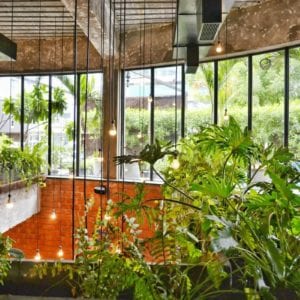
The Rising Popularity of Sustainable Architecture
With our society’s increasing concern for the environment, it’s no surprise that green building continues to grow in popularity and you may be wondering what is green design? From residential structures to corporate facilities, architects are discovering new sustainable design processes to preserve our ecosystem while reducing our carbon footprint. Here are ten benefits of green building and green construction practices and how this architectural trend can protect the generations of tomorrow :
Improved Indoor Environment: Quality of Life
When it comes to our quality of life, it’s no secret that our surroundings have a major impact on our health. Over the past several decades, designers around the globe have made massive progress, developing sustainable architecture that can dramatically affect the inhabitants of such buildings and drastically reduce the negative environmental impact that buildings may have. From interior design elements like improved lighting sources, thermal conditions, ergonomic features and even upgraded air quality, occupants residing or working in green structures have experienced a marked improvement in their health, stress levels and overall quality of life.
Saving Water: Reduce, Reuse, Replenish
Another tangible benefit of sustainable building: water efficiency. Research shows that green architecture can not only reduce water waste through water-efficient plumbing fixtures but also reduce the strain on shared water resources. By installing specially-engineered systems to purify water, it enables water recycling and also allows for alternative sources of water (such as rainwater). These developments not only save this vital natural resource but protect clean water sources for the future.
Enhanced Health: Eco-Friendly For Life
Living in a sustainable building can save your life – literally. According to studies, people who reside in green structures experience a myriad of health benefits due to the eco-friendly materials utilized in construction. For example, green buildings avoid using building materials that may contain harmful volatile organic compounds (VOCs) or plastic by-products which have been known to release toxic fumes and carcinogens into the atmosphere. These dangerous materials are linked to respiratory disease, allergies, and other health disorders, and in extreme cases, an increased risk of cancer.
Reducing The Strain: Shared Resources, Increased Efficiency
With our planet’s ever-increasing population (particularly in large cities across the globe), our local shared resources are being threatened as demands continue to grow. Based on the advancements and sustainable practices and technologies developed by ingenious architects worldwide, vital resources such as water and energy are being protected. By increasing efficiency, green structures are capable of reducing the environmental impact on such resources, which can potentially be protected and preserved for future generations.
Reduced Operational Cost and Maintenance: Traditional vs. Green
One of the greatest benefits of green buildings are their lower maintenance costs – featuring specially-engineered design elements to lower energy consumption and help reduce energy cost and water bills for each occupant. These efficient structures can save corporate and residential owners a bundle. Although the expense required for building owners to build such structures may be initially higher than traditional non-green forms of architecture, the cost over the long term is recovered exponentially.
Energy-Efficient: Non-Renewable vs. Natural Resources
As a green architect, energy efficiency is a primary goal in green building design. Developing structures that derive their energy from natural sources – such as the sun, wind, and water – is extremely beneficial to the environment, protecting the ecosystem from pollution associated with non-renewable sources (such as oil and coal). An added benefit: non-renewable energy sources are not only toxic but costly, while their energy-efficient counterparts (such as solar energy vs. traditional electricity) can save thousands over the lifetime costs of the infrastructure.
Carbon Footprint Reduction: Saving The Planet One Step At A Time
There has been an increase in large corporations opting for green initiatives. According to the Environmental Protection Agency (EPA) , buildings account for 30% of all greenhouse gas emissions in the United States. Landlords and large businesses have taken heed, as increasing sustainability is an opportunity to do something positive for both business and society as a whole.
Keep It Clean: Protecting Our Ecosystem
Global warming has been a growing concern for a number of years, and it’s no wonder – our planet has seen a drastic depletion of our natural resources, while pollution and the consequent climate-change is at an all-time high. Sustainable architecture is not only energy-efficient and healthier for its inhabitants, but it also benefits the planet. By reducing our reliance on non-renewable resources (fossil fuels such as coal and oil), green architecture can actually promote and maintain a cleaner environment.
Efficient & Sustainable Material: Minimal Use For Maximum Impact
Upcycling has taken the architectural world by storm – by using recycled material and reusing resources (and even repurposing old structures), sustainable architects, engineers, and green designers are tapping into existing resources to reduce carbon footprints and save natural resources. By implementing sustainable strategies into the design process, like reducing waste, preserving natural resources (such as water and wood), protecting our air supply, and limiting energy use, green building companies can create extremely efficient structures that can withstand the test of time.
Durability For The Green Homeowner: Built To Last
For educated homeowners, going green is a no-brainer: from energy and water savings and improved air quality to overall durability, sustainable materials have been proven time and time again to last longer. Green materials (such as recycled decking and roofing) not only endure for years exposed to the elements but require much less maintenance. In addition, because many of them are free from harmful chemical treatments, they are healthier for the environment (and the inhabitants they serve).
Check out one of the ways we’re reducing our carbon footprint at NewSchool, here . Or, learn more about our related programs, like our Interior Architecture & Design degree.
- eco-friendly design
- green architecture
- green building
- green design
- sustainable architecture
- sustainable design
What Does an Interior Designer Do?

Recent Posts
Tips for searching for a job in architecture and design, perks of joining newschool of architecture & design, tips for securing an internship in architecture & design, student life at newschool of architecture & design, mastering the art of design portfolios: tips and tricks, recent comments, begin your journey towards a promising future.
- Integrative Studies
Advertisement
A comprehensive review on green buildings research: bibliometric analysis during 1998–2018
- Environmental Concerns and Pollution control in the Context of Developing Countries
- Published: 16 February 2021
- Volume 28 , pages 46196–46214, ( 2021 )
Cite this article

- Li Ying 1 , 2 ,
- Rong Yanyu ORCID: orcid.org/0000-0003-0722-8510 1 , 3 ,
- Umme Marium Ahmad 1 ,
- Wang Xiaotong 1 , 3 ,
- Zuo Jian 4 &
- Mao Guozhu 1 , 3
55 Citations
Explore all metrics
Buildings account for nearly 2/5ths of global energy expenditure. Due to this figure, the 90s witnessed the rise of green buildings (GBs) that were designed with the purpose of lowering the demand for energy, water, and materials resources while enhancing environmental protection efforts and human well-being over time. This paper examines recent studies and technologies related to the design, construction, and overall operation of GBs and determines potential future research directions in this area of study. This global review of green building development in the last two decades is conducted through bibliometric analysis on the Web of Science, via the Science Citation Index and Social Sciences Citation Index databases. Publication performance, countries’ characteristics, and identification of key areas of green building development and popular technologies were conducted via social network analysis, big data method, and S-curve predictions. A total of 5246 articles were evaluated on the basis of subject categories, journals’ performance, general publication outputs, and other publication characteristics. Further analysis was made on dominant issues through keyword co-occurrence, green building technologies by patent analysis, and S-curve predictions. The USA, China, and the UK are ranked the top three countries where the majority of publications come from. Australia and China had the closest relationship in the global network cooperation. Global trends of the top 5 countries showed different country characteristics. China had a steady and consistent growth in green building publications each year. The total publications on different cities had a high correlation with cities’ GDP by Baidu Search Index. Also, barriers and contradictions such as cost, occupant comfort, and energy consumption were discussed in developed and developing countries. Green buildings, sustainability, and energy efficiency were the top three hotspots identified through the whole research period by the cluster analysis. Additionally, green building energy technologies, including building structures, materials, and energy systems, were the most prevalent technologies of interest determined by the Derwent Innovations Index prediction analysis. This review reveals hotspots and emerging trends in green building research and development and suggests routes for future research. Bibliometric analysis, combined with other useful tools, can quantitatively measure research activities from the past and present, thus bridging the historical gap and predicting the future of green building development.
Similar content being viewed by others

Scientometric of Nearly Zero Energy Building Research: A Systematic Review from the Perspective of Co-Citation Analysis

Determining Technologies Trends and Evolution of Smart Building Technologies by Bibliometric Analysis from 1984 to 2020

Determining Technologies Trends and Evolution of Smart Building Technologies by Bibliometric Analysis from 1984 to 2020
Avoid common mistakes on your manuscript.
Introduction
Rapid urban development has resulted in buildings becoming a massive consumer of energy (Yuan et al. 2013 ), liable for 39% of global energy expenditure and 68% of total electricity consumption in the USA (building). In recent years, green buildings (GBs) have become an alternative solution, rousing widespread attention. Also referred to as sustainable buildings, low energy buildings, and eco-buildings, GBs are designed to reduce the strain on environmental resources as well as curb negative effects on human health by efficiently using natural resources, reducing garbage, and ensuring the residents’ well-being through improved living conditions ( Agency USEP Indoor Air Quality ; Building, n.d ). As a strategy to improve the sustainability of the construction industry, GBs have been widely recognized by governments globally, as a necessary step towards a sustainable construction industry (Shen et al. 2017 ).
Zuo and Zhao ( 2014 ) reviewed the current research status and future development direction of GBs, focusing on connotation and research scope, the benefit-difference between GBs and traditional buildings, and various ways to achieve green building development. Zhao et al. ( 2019 ) presented a bibliometric report of studies on GBs between 2000 and 2016, identifying hot research topics and knowledge gaps. The verification of the true performance of sustainable buildings, the application of ICT, health and safety hazards in the development of green projects, and the corporate social responsibility were detected as future agenda. A scientometrics review of research papers on GB sources from 14 architectural journals between 1992 and 2018 was also presented (Wuni et al. 2019a ). The study reported that 44% of the world participated in research focusing on green building implementation; stakeholder management; attitude assessment; regulations and policies; energy efficiency assessment; sustainability performance assessment; green building certification, etc.
With the transmission of the COVID-19 virus, society is now aware of the importance of healthy buildings. In fact, in the past 20 years, the relationship between the built environment and health has aroused increasing research interest in the field of building science. Public spaces and dispersion of buildings in mixed-use neighborhoods are promoted. Furthermore, telecommuting has become a trend since the COVID-19 pandemic, making indoor air quality even more important in buildings, now (Fezi 2020 ).
The system for evaluating the sustainability of buildings has been established for nearly two decades. But, systems dedicated to identifying whether buildings are healthy have only recently appeared (McArthur and Powell 2020 ). People are paying more and more attention to health factors in the built environment. This is reflected in the substantial increase in related academic papers and the increase in health building certification systems such as WELE and Fitwel (McArthur and Powell 2020 ).
Taking the above into consideration, the aim of this study is to examine the stages of development of GBs worldwide and find the barriers and the hotpots in global trends. This study may be beneficial to foreign governments interested in promoting green building and research in their own nations.
Methodology
Overall description of research design.
Since it is difficult to investigate historical data and predict global trends of GBs, literature research was conducted to analyze their development. The number of published reports on a topic in a particular country may influence the level of industrial development in that certain area (Zhang et al. 2017 ). The bibliometric analysis allows for a quantitative assessment of the development and advancement of research related to GBs and where they are from. Furthermore, it has been shown that useful data has been gathered through bibliometrics and patent analysis (Daim et al. 2006 ).
In this report, the bibliometric method, social network analysis (SNA), CiteSpace, big data method, patent analysis, and S-curve analysis are used to assess data.
Bibliometrics analysis
Bibliometrics, a class of scientometrics, is a tool developed in 1969 for library and information science. It has since been adopted by other fields of study that require a quantitative assessment of academic articles to determine trends and predict future research scenarios by compiling output and type of publication, title, keyword, author, institution, and countries data (Ho 2008 ; Li et al. 2017 ).
Social network analysis
Social network analysis (SNA) is applied to studies by modeling network maps using mathematics and statistics (Mclinden 2013 ; Ye et al. 2013 ). In the SNA, nodes represent social actors, while connections between actors stand for their relationships (Zhang et al. 2017 ). Correlations between two actors are determined by their distance from each other. There is a variety of software for the visualization of SNA such as Gephi, Vosviewer, and Pajek. In this research, “Pajek” was used to model the sequence of and relationships between the objects in the map (Du et al. 2015 ).
CiteSpace is an open-source Java application that maps and analyzes trends in publication statistics gathered from the ISI-Thomson Reuters Scientific database and produces graphic representations of this data (Chen 2006 ; Li et al. 2017 ). Among its many functions, it can determine critical moments in the evolution of research in a particular field, find patterns and hotspots, locate areas of rapid growth, and breakdown the network into categorized clusters (Chen 2006 ).
Big data method
The big data method, with its 3V characters (volume, velocity, and variety), can give useful and accurate information. Enormous amounts of data, which could not be collected or computed manually through conventional methods, can now be collected through public data website. Based on large databases and machine learning, the big data method can be used to design, operate, and evaluate energy efficiency and other index combined with other technologies (Mehmood et al. 2019 ). The primary benefit of big data is that the data is gathered from entire populations as opposed to a small sample of people (Chen et al. 2018 ; Ho 2008 ). It has been widely used in many research areas. In this research, we use the “Baidu Index” to form a general idea of the trends in specific areas based on user interests. The popularity of the keywords could imply the user’s behavior, user’s demand, user’s portrait, etc. Thus, we can analyze the products or events to help with developing strategies. However, it must be noted that although big data can quantitatively represent human behavior, it cannot determine what motivates it. With the convergence of big data and technology, there are unprecedented applications in the field of green building for the improved indoor living environment and controlled energy consumption (Marinakis 2020 ).
- Patent analysis
Bibliometrics, combined with patent analysis, bridges gaps that may exist in historical data when predicting future technologies (Daim et al. 2006 ). It is a trusted form of technical analysis as it is supported by abundant sources and commercial awareness of patents (Guozhu et al. 2018 ; Yoon and Park 2004 ). Therefore, we used patent analysis from the Derwent patent database to conduct an initial analysis and forecast GB technologies.
There are a variety of methods to predict the future development prospects of a technology. Since many technologies are developed in accordance with the S-curve trend, researchers use the S-curve to observe and predict the future trend of technologies (Bengisu and Nekhili 2006 ; Du et al. 2019 ; Liu and Wang 2010 ). The evolution of technical systems generally goes through four stages: emerging, growth, maturity, and decay (saturation) (Ernst 1997 ). We use the logistics model (performed in Loglet Lab 4 software developed by Rockefeller University) to simulate the S-curve of GB-related patents to predict its future development space.
Data collection
The Web of Science (WOS) core collection database is made up of trustworthy and highly ranked journals. It is considered the leading data portal for publications in many fields (Pouris and Pouris 2011 ). Furthermore, the WOS has been cited as the main data source in many recent bibliometric reviews on buildings (Li et al. 2017 ).
Access to all publications used in this paper was attained through the Science Citation Index-Expanded and the Social Sciences Citation Index databases. Because there is no relevant data in WOS before 1998, our examination focuses on 1998 to 2018. With consideration of synonyms, we set a series of green building-related words (see Appendix ) in titles, abstracts, and keywords for bibliometric analysis. For example, sustainable, low energy, zero energy, and low carbon can be substituted for green; housing, construction, and architecture can be a substitute for building (Zuo and Zhao 2014 ).
Analytical procedure
The study was conducted in three stages; data extraction was the first step where all the GB-related words were screened in WOS. Afterwards, some initial analysis was done to get a complete idea of GB research. Then, we made a further analysis on countries’ characteristics, dominant issues, and detected technology hotspots via patent analysis (Fig. 1 ).
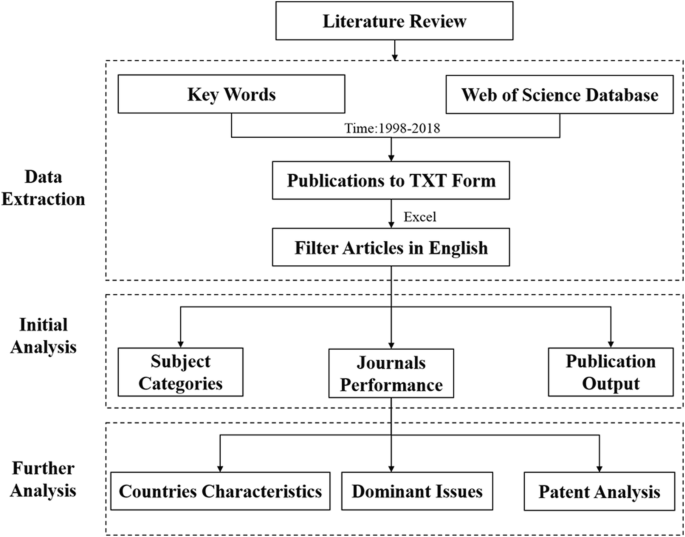
Analytical procedure of the article
Results and analysis
General results.
Of the 6140 publications searched in the database, 88.67% were articles, followed by reviews (6.80%), papers (3.72%), and others (such as editorial materials, news, book reviews). Most articles were written in English (96.78%), followed by German (1.77%), Spanish (0.91%), and other European languages. Therefore, we will only make a further analysis of the types of articles in English publications.
The subject categories and their distribution
The SCI-E and SSCI database determined 155 subjects from the pool of 5246 articles reviewed, such as building technology, energy and fuels, civil engineering, environmental, material science, and thermodynamics, which suggests green building is a cross-disciplinary area of research. The top 3 research areas of green buildings are Construction & Building Technology (36.98%), Energy & Fuels (30.39%), and Engineering Civil (29.49%), which account for over half of the total categories.
The journals’ performance
The top 10 journals contained 38.8% of the 5246 publications, and the distribution of their publications is shown in Fig. 2 . Impact factors qualitatively indicate the standard of journals, the research papers they publish, and researchers associated with those papers (Huibin et al. 2015 ). Below, we used 2017 impact factors in Journal Citation Reports (JCR) to determine the journal standards.

The performance of top10 most productive journals
Publications on green building have appeared in a variety of titles, including energy, building, environment, materials, sustainability, indoor built environment, and thermal engineering. Energy and Buildings, with its impact factor 4.457, was the most productive journal apparently from 2009 to 2017. Sustainability (IF = 2.075) and Journal of Cleaner Production (IF = 5.651) rose to significance rapidly since 2015 and ranked top two journals in 2018.
Publication output
The total publication trends from 1998 to 2018 are shown in Fig. 3 , which shows a staggering increase across the 10 years. Since there was no relevant data before 1998, the starting year is 1998. Before 2004, the number of articles published per year fluctuated. The increasing rate reached 75% and 68% in 2004 and 2007, respectively, which are distinguished in Fig. 3 that leads us to believe that there are internal forces at work, such as appropriate policy creation and enforcement by concerned governments. There was a constant and steady growth in publications after 2007 in the worldwide view.
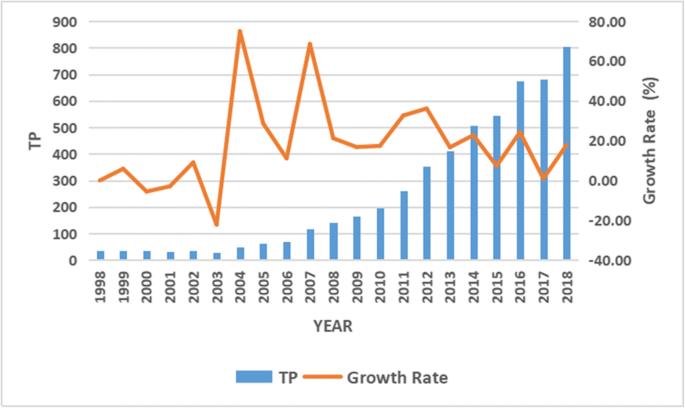
The number of articles published yearly, between 1998 and 2018
The characteristics of the countries
Global distribution and global network were analyzed to illustrate countries’ characteristics. Many tools such as ArcGIS, Bibexcel, Pajek, and Baidu index were used in this part (Fig. 4 ).
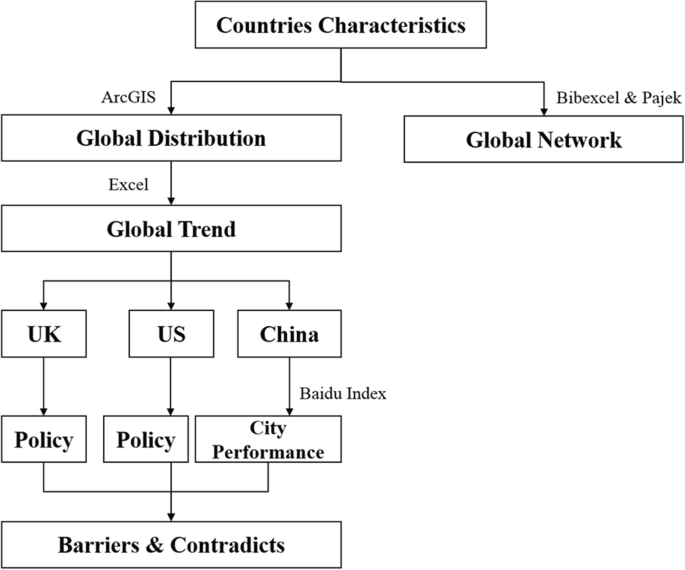
Analysis procedure of countries’ characteristics
Global distribution of publications
By extracting the authors’ addresses (Mao et al. 2015 ), the number of publications from each place was shown in Fig. 5 and Table 1 . Apparently, the USA was the most productive country accounting for 14.98% of all the publications. China (including Hong Kong and Taiwan) and the UK followed next by 13.29% and 8.27% separately. European countries such as Italy, Spain, and Germany also did a lot of work on green building development.
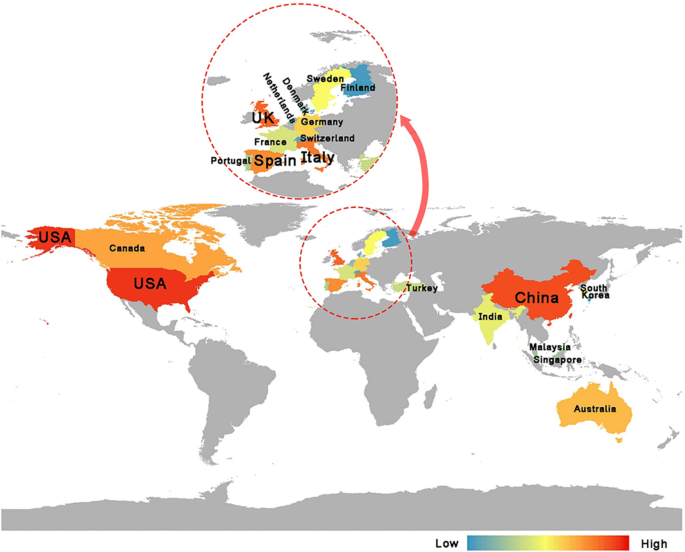
Global geographical distribution of the top 20 publications based on authors’ locations
Global research network
Global networks illustrate cooperation between countries through the analysis of social networks. Academic partnerships among the 10 most productive countries are shown in Fig. 6 . Collaboration is determined by the affiliation of the co-authors, and if a publication is a collaborative research, all countries or institutions will benefit from it (Bozeman et al. 2013 ). Every node denotes a country and their size indicates the amount of publications from that country. The lines linking the nodes denote relationships between countries and their thickness indicates the level of collaboration (Mao et al. 2015 ).

The top 10 most productive countries had close academic collaborative relationships
It was obvious that China and Australia had the strongest linking strength. Secondly, China and the USA, China, and the UK also had close cooperation with each other. Then, the USA with Canada and South Korea followed. The results indicated that cooperation in green building research was worldwide. At the same time, such partnerships could help countries increase individual productivity.
Global trend of publications
The time-trend analysis of academic inputs to green building from the most active countries is shown in Fig. 7 .
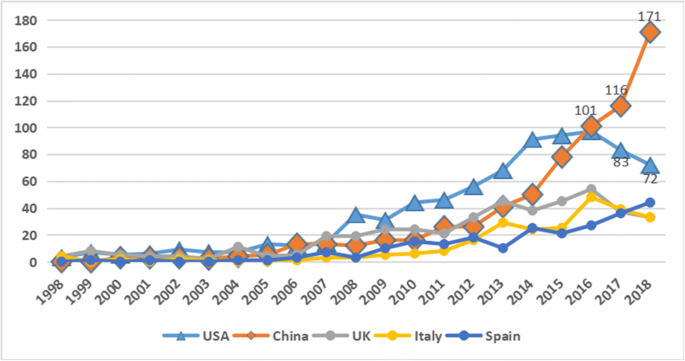
The publication trends of the top five countriesbetween 1998 and 2018 countries areshown in Fig 7 .
Before 2007, these countries showed little growth per year. However, they have had a different, growing trend since 2007. The USA had the greatest proportion of publications from 2007, which rose obviously each year, reaching its peak in 2016 then declined. The number of articles from China was at 13 in 2007, close to the USA. Afterwards, there was a steady growth in China. Not until 2013 did China have a quick rise from 41 publications to 171 in 2018. The UK and Italy had a similar growth trend before 2016 but declined in the last 2 years.
Further analysis on China, the USA, and the UK
Green building development in china, policy implementation in china.
Green building design started in China with the primary goal of energy conservation. In September 2004, the award of “national green building innovation” of the Ministry of Construction was launched, which kicked off the substantive development of GB in China. As we can see from Fig. 7 , there were few publications before 2004 in China. In 2004, there were only 4 publications on GB.
The Ministry of Construction, along with the Ministry of Science and Technology, in 2005, published “The Technical Guidelines for Green Buildings,” proposing the development of GBs (Zhang et al. 2018 ). In June 2006, China had implemented the first “Evaluation Standard for Green Building” (GB/T 50378-2006), which promoted the study of the green building field. In 2007, the demonstration of “100 projects of green building and 100 projects of low-energy building” was launched. In August 2007, the Ministry of Construction issued the “Green Building Assessment Technical Regulations (try out)” and the “Green Building Evaluation Management,” following Beijing, Tianjin, Chongqing, and Shanghai, more than 20 provinces and cities issued the local green building standards, which promoted GBs in large areas in China.
At the beginning of 2013, the State Council issued the “Green Building Action Plan,” so the governments at all levels continuously issued incentive policies for the development of green buildings (Ye et al. 2015 ). The number of certified green buildings has shown a blowout growth trend throughout the country, which implied that China had arrived at a new chapter of development.
In August 2016, the Evaluation Standard for Green Renovation of Existing Buildings was released, encouraging the rise of residential GB research. Retrofitting an existing building is often more cost-effective than building a new facility. Designing significant renovations and alterations to existing buildings, including sustainability measures, will reduce operating costs and environmental impacts and improve the building’s adaptability, durability, and resilience.
At the same time, a number of green ecological urban areas have emerged (Zhang et al. 2018 ). For instance, the Sino-Singapore Tianjin eco-city is a major collaborative project between the two governments. Located in the north of Tianjin Binhai New Area, the eco-city is characterized by salinization of land, lack of freshwater, and serious pollution, which can highlight the importance of eco-city construction. The construction of eco-cities has changed the way cities develop and has provided a demonstration of similar areas.
China has many emerging areas and old centers, so erecting new, energy efficiency buildings and refurbishing existing buildings are the best steps towards saving energy.
Baidu Search Index of “green building”
In order to know the difference in performance among cities in China, this study employs the big data method “Baidu Index” for a smart diagnosis and assessment on green building at finer levels. “Baidu Index” is not equal to the number of searches but is positively related to the number of searches, which is calculated by the statistical model. Based on the keyword search of “green building” in the Baidu Index from 2013 to 2018, the top 10 provinces or cities were identified (Fig. 8 ).
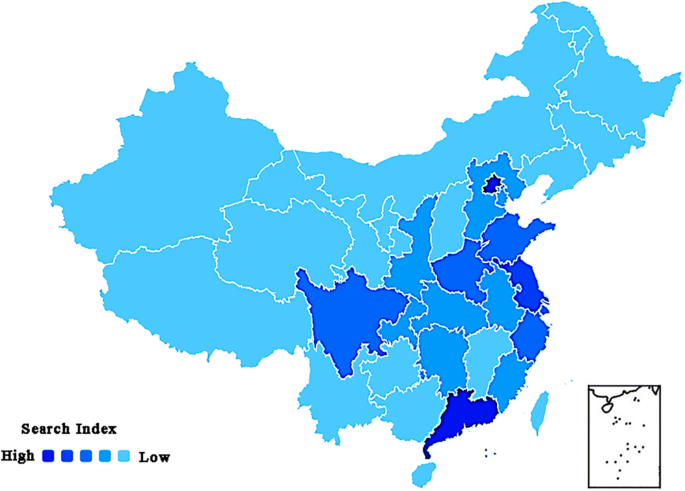
Baidu Search Index of green building in China 2013–2018 from high to low
The top 10 search index distributes the east part and middle part of China, most of which are the high GDP provinces (Fig. 9 ). Economically developed cities in China already have a relatively mature green building market. Many green building projects with local characteristics have been established (Zhang et al. 2018 ).
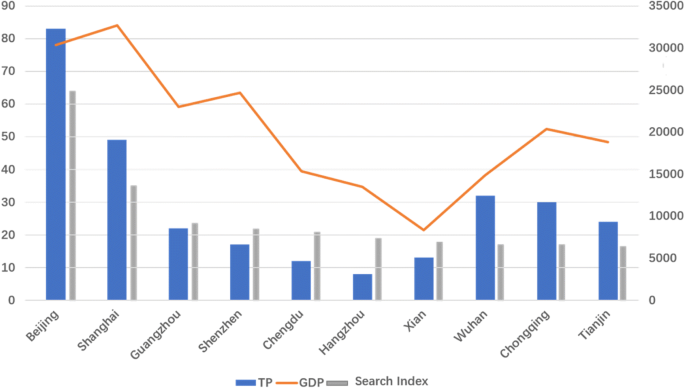
TP GDP & Search Index were highly related
We compared the city search index (2013–2018) with the total publications of different cities by the authors’ address and the GDP in 2018. The correlation coefficient between the TP and the search index was 0.9, which means the two variables are highly related. The correlation coefficient between the TP and GDP was 0.73, which also represented a strong relationship. We inferred that cities with higher GDP had more intention of implementation on green buildings. The stronger the local GDP, the more relevant the economic policies that can be implemented to stimulate the development of green buildings (Hong et al. 2017 ). Local economic status (Yang et al. 2018 ), property developer’s ability, and effective government financial incentives are the three most critical factors for green building implementation (Huang et al. 2018 ). However, Wang et al. ( 2017 ) compared the existing green building design standards and found that they rarely consider the regional economy. Aiming at cities at different economic development phases, the green building design standards for sustainable construction can effectively promote the implementation of green buildings. Liu et al. ( 2020 ) mainly discussed the impact of sustainable construction on GDP. According to the data, there is a strong correlation between the percentage of GDP increments in China and the amount of sustainable infrastructure (Liu et al. 2020 ). The construction of infrastructure can create jobs and improve people’s living standards, increasing GDP as a result (Liu et al. 2020 ).
Green building development in the USA and the UK
The sign that GBs were about to take-off occurred in 1993—the formation of the United States Green Building Council (USGBC), an independent agency. The promulgation of the Energy Policy Act 2005 in the USA was the key point in the development of GBs. The Energy Policy Act 2005 paid great attention to green building energy saving, which also inspired publications on GBs.
Leadership in Energy and Environmental Design (LEED), a popular metric for sustainable buildings and homes (Jalaei and Jrade 2015 ), has become a thriving business model for green building development. It is a widely used measure of how buildings affect the environment.
Another phenomenon worth discussion, combined with Fig. 7 , the increasing rate peaked at 75% in 2004 and 68% in 2007 while the publications of the UK reached the peak in 2004 and 2007. The UK Green Building Council (UKGBC), a United Kingdom membership organization, created in 2007 with regard to the 2004 Sustainable Building Task Group Report: Better Buildings - Better Lives, intends to “radically transform,” all facets of current and future built environment in the UK. It is predicted that the establishment of the UKGBC promoted research on green buildings.
From the China, the USA, and the UK experience, it is predicted that the foundation of a GB council or the particular projects from the government will promote research in this area.
Barriers and contradicts of green building implement
On the other hand, it is obvious that the USA, the UK, and Italian publications have been declining since 2016. There might be some barriers and contradicts on the adoption of green buildings for developed countries. Some articles studied the different barriers to green building in developed and developing countries (Chan et al. 2018 ) (Table 2 ). Because the fraction of energy end-uses is different, the concerns for GBs in the USA, China, and the European Union are also different (Cao et al. 2016 ).
It is regarded that higher cost is the most deterring barrier to GB development across the globe (Nguyen et al. 2017 ). Other aspects such as lack of market demand and knowledge were also main considerations of green building implementation.
As for market demand, occupant satisfaction is an important factor. Numerous GB post-occupancy investigations on occupant satisfaction in various communities have been conducted.
Paul and Taylor ( 2008 ) surveyed personnel ratings of their work environment with regard to ambience, tranquility, lighting, sound, ventilation, heat, humidity, and overall satisfaction. Personnel working in GBs and traditional buildings did not differ in these assessments. Khoshbakht et al. ( 2018 ) identified two global contexts in spite of the inconclusiveness: in the west (mainly the USA and Britain), users experienced no significant differences in satisfaction between green and traditional buildings, whereas, in the east (mainly China and South Korea), GB user satisfaction is significantly higher than traditional building users.
Dominant issues
The dominant issues on different stages.
Bibliometric data was imported to CiteSpace where a three-stage analysis was conducted based on development trends: 1998–2007 initial development; 2008–2015 quick development; 2016–2018 differentiation phase (Fig. 10 ).
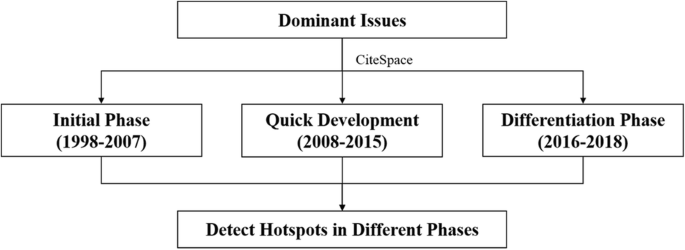
Analysis procedure of dominant issues
CiteSpace was used for word frequency and co-word analysis. The basic principle of co-word analysis is to count a group of words appearing at the same time in a document and measure the close relationship between them by the number of co-occurrences. The top 50 levels of most cited or occurred items from each slice (1998 to 2007; 2008 to 2015; 2016 to 2018) per year were selected. After merging the similar words (singular or plural form), the final keyword knowledge maps were generated as follows.
Initial phase (1998–2007)
In the early stage (Fig. 11 ), “green building” and “sustainability” were the main two clusters. Economics and “environmental assessment method” both had high betweenness centrality of 0.34 which were identified as pivotal points. Purple rings denote pivotal points in the network. The relationships in GB were simple at the initial stage of development.
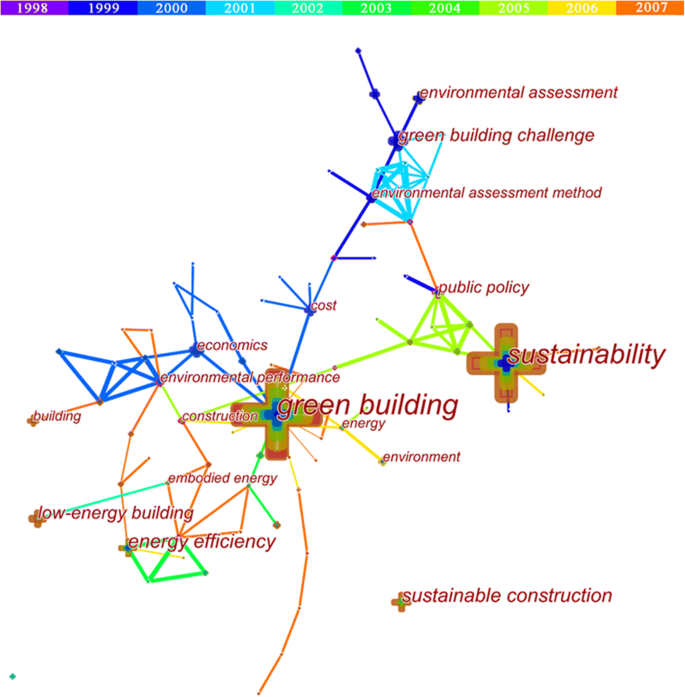
Co-word analysis from 1998–2007
Sustainable construction is further enabled with tools that can evaluate the entire life cycle, site preparation and management, materials and their reusability, and the reduction of resource and energy consumption. Environmental building assessment methods were incorporated to achieve sustainable development, especially at the initial project appraisal stage (Ding 2008 ). Green Building Challenge (GBC) is an exceptional international research, development, and dissemination effort for developing building environmental performance assessments, primarily to help researchers and practitioners in dealing with difficult obstacles in assessing performance (Todd et al. 2001 ).
Quick development (2008–2015)
In the rapid growing stage (Fig. 12 ), pivot nodes and cluster centers were more complicated. Besides “green building” and “sustainability,” “energy efficiency” was the third hotspot word. The emergence of new vocabulary in the keyword network indicated that the research had made progress during 2008 – 2015. Energy performance, energy consumption, natural ventilation, thermal comfort, renewable energy, and embodied energy were all energy related. Energy becomes the most attractive field in achieving sustainability and green building. Other aspects such as “life cycle assessment,” “LEED,” and “thermal comfort” became attractive to researchers.
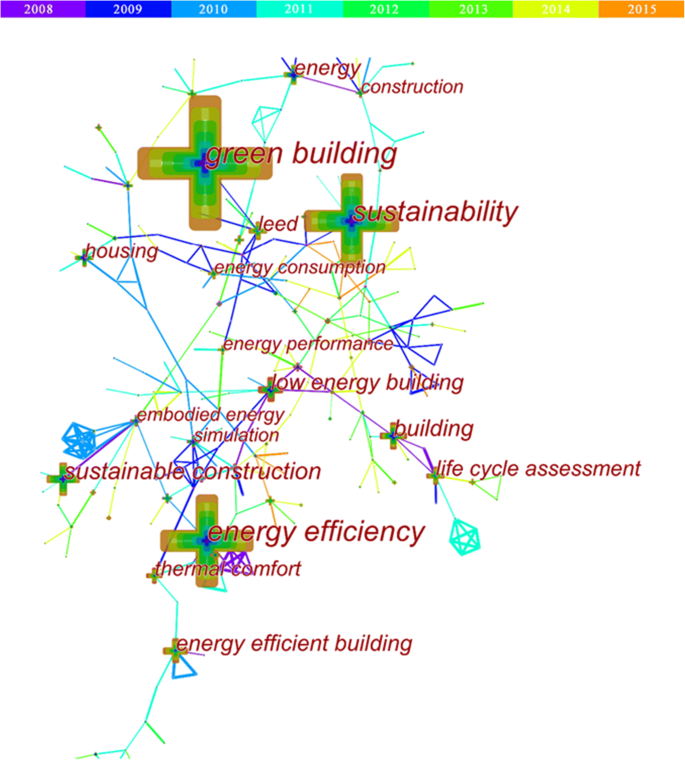
Co-word analysis from 2008–2015
The life cycle assessment (LCA) is a popular technique for the analysis of the technical side of GBs. LCA was developed from environmental assessment and economic analysis which could be a useful method to evaluate building energy efficiency from production and use to end-use (Chwieduk 2003 ). Much attention has been paid to LCA because people began to focus more on the actual performance of the GBs. Essentially, LCA simplifies buildings into systems, monitoring, and calculating mass flow and energy consumption over different stages in their life cycle.
Leadership in Energy and Environmental Design (LEED) was founded by the USGBC and began in the early twenty-first century (Doan et al. 2017 ). LEED is a not-for-profit project based on consumer demand and consensus that offers an impartial GB certification. LEED is the preferred building rating tool globally, with its shares growing rapidly. Meanwhile, UK’s Building Research Establishment Assessment Method (BREEAM) and Japan’s Comprehensive Assessment System for Building Environmental Efficiency (CASBEE) have been in use since the beginning of the twenty-first century, while New Zealand’s Green Star is still in its earlier stages. GBs around the world are made to suit regional climate concerns and need.
In practice, not all certified green buildings are necessarily performing well. Newsham et al. ( 2009 ) gathered energy-use information from 100 LEED-certified non-residential buildings. Results indicated that 28–35% of LEED structures actually consumed higher amounts of energy than the non-LEED structures. There was little connection in its actual energy consumption to its certification grade, meaning that further improvements are required for establishing a comprehensive GB rating metric to ensure consistent performance standards.
Thermal comfort was related to many aspects, such as materials, design scheme, monitoring system, and human behaviors. Materials have been a focus area for improving thermal comfort and reducing energy consumption. Wall (Schossig et al. 2005 ), floor (Ansuini et al. 2011 ), ceiling (Hu et al. 2018 ), window, and shading structures (Shen and Li 2016 ) were building envelopes which had been paid attention to over the years. Windows were important envelopes to improve thermal comfort. For existing and new buildings, rational use of windows and shading structures can enhance the ambient conditions of buildings (Mcleod et al. 2013 ). It was found that redesigning windows could reduce the air temperature by 2.5% (Elshafei et al. 2017 ), thus improving thermal comfort through passive features and reducing the use of active air conditioners (Perez-Fargallo et al. 2018 ). The monitoring of air conditioners’ performance could also prevent overheating of buildings (Ruellan and Park 2016 ).
Differentiation phase (2016–2018)
In the years from 2016 to 2018 (Fig. 13 ), “green building,” ”sustainability,” and “energy efficiency” were still the top three hotspots in GB research.
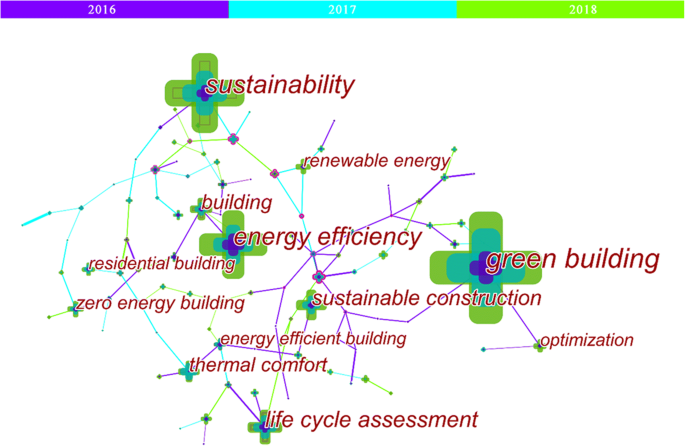
Co-word analysis from 2016–2018
Zero-energy building (ZEB) became a substitute for low energy building in this stage. ZEB was first introduced in 2000 (Cao et al. 2016 ) and was believed to be the solution to the potential ramifications of future energy consumption by buildings (Liu et al. 2019 ). The EU has been using ZEB standards in all of its new building development projects to date (Communuties 2002 ). The USA passed the Energy Independence and Security Act of 2007, aiming for zero net energy consumption of 1 out of every 2 commercial buildings that are yet to be built by 2040 and for all by 2050 (Sartori et al. 2012 ). Energy consumption became the most important factor in new building construction.
Renewable energy was a key element of sustainable development for mankind and nature (Zhang et al. 2013 ). Using renewable energy was an important feature of ZEBs (Cao et al. 2016 ; Pulselli et al. 2007 ). Renewable energy, in the form of solar, wind, geothermal, clean bioenergy, and marine can be used in GBs. Solar energy has been widely used in recent years while wind energy is used locally because of its randomness and unpredictable features. Geothermal energy is mainly utilized by ground source heat pump (GSHP), which has been lauded as a powerful energy system for buildings (Cao et al. 2016 ). Bioenergy has gained much popularity as an alternative source of energy around the globe because it is more stable and accessible than other forms of energy (Zhang et al. 2015 ). There is relatively little use of marine energy, yet this may potentially change depending on future technological developments (Ellabban et al. 2014 ).
Residential buildings receive more attention because people spend 90% of their time inside. Contrary to popular belief, the concentration of contaminants found indoors is more than the concentration outside, sometimes up to 10 times or even 100 times more (agency). The renovation of existing buildings can save energy, upgrade thermal comfort, and improve people’s living conditions.
Energy is a substantial and widely recognized cost of building operations that can be reduced through energy-saving and green building design. Nevertheless, a consensus has been reached by academics and those in building-related fields that GBs are significantly more energy efficient than traditional buildings if designed, constructed, and operated with meticulousness (Wuni et al. 2019b ). The drive to reduce energy consumption from buildings has acted as a catalyst in developing new technologies.
Compared with the article analysis, patents can better reflect the practical technological application to a certain extent. We extracted the information of green building energy-related patent records between 1998 and 2018 from the Derwent Innovations Index database. The development of a technique follows a path: precursor–invention–development–maturity. This is commonly known as an S-type growth (Mao et al. 2018 ). Two thousand six hundred thirty-eight patents were found which were classified into “Derwent Manual Code,” which is the most distinct feature just like “keywords” in the Derwent Innovations Index. Manual codes refer to specific inventions, technological innovations, and unique codes for their applications. According to the top 20 Derwent Manual Code which accounted for more than 80% of the total patents, we classified the hotspots patents into three fields for further S-curve analysis, which are “structure,” “material,” and “energy systems” (Table 3 ).
Sustainable structural design (SSD) has gained a lot of research attention from 2006 to 2016 (Pongiglione and Calderini 2016 ). The S-curve of structure* (Fig. 14 ) has just entered the later period of the growth stage, accounting for 50% of the total saturation in 2018. Due to its effectiveness and impact, SSD has overtime gained recognition and is now considered by experts to be a prominent tool in attaining sustainability goals (Pongiglione and Calderini 2016 ).
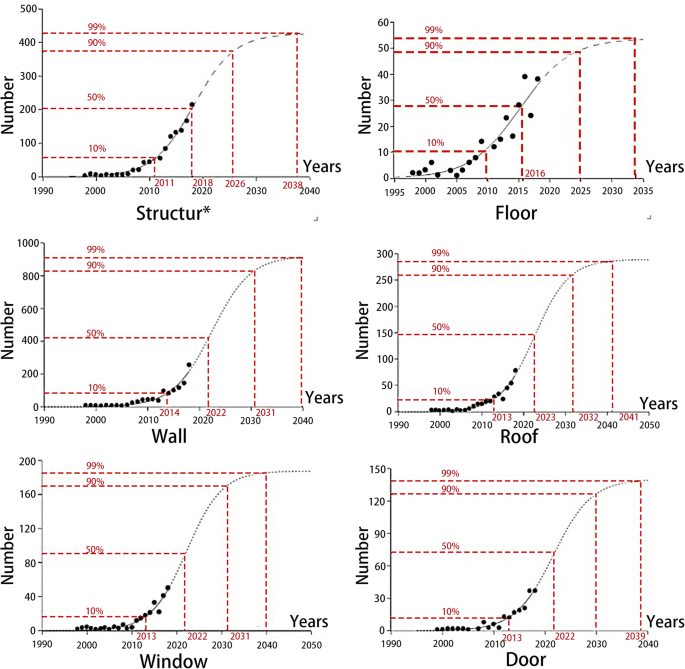
The S-curves of different Structure types from patents
Passive design is important in energy saving which is achieved by appropriately orientating buildings and carefully designing the building envelope. Building envelopes, which are key parts of the energy exchange between the building and the external environment, include walls, roofs, windows, and floors. The EU increased the efficiency of its heat-regulating systems by revamping building envelopes as a primary energy-saving task during 2006 to 2016 (Cao et al. 2016 ).
We analyzed the building envelope separately. According to the S-curve (Fig. 14 ), the number of patents related to GB envelops are in the growth stage. At present, building envelops such as walls, roofs, windows, and even doors have not reached 50% of the saturated quantity. Walls and roofs are two of the most important building envelops. The patent contents of walls mainly include wall materials and manufacturing methods, modular wall components, and wall coatings while technologies about roofs mainly focus on roof materials, the combination of roof and solar energy, and roof structures. Green roofs are relatively new sustainable construction systems because of its esthetic and environmental benefits (Wei et al. 2015 ).
The material resources used in the building industry consume massive quantities of natural and energy resources consumptions (Wang et al. 2018 ). The energy-saving building material is economical and environmentally friendly, has low coefficient heat conductivity, fast curing speed, high production efficacy, wide raw material source and flame, and wear resistance properties (Zhang et al. 2014 ). Honeycomb structures were used for insulating sustainable buildings. They are lightweight and conserve energy making them eco-friendly and ideal for construction (Miao et al. 2011 ).
According to the S-curve (Fig. 15 ), it can be seen that the number of patents on the GB “material” is in the growth stage. It is expected that the number of patents will reach 50% of the total saturation in 2022.
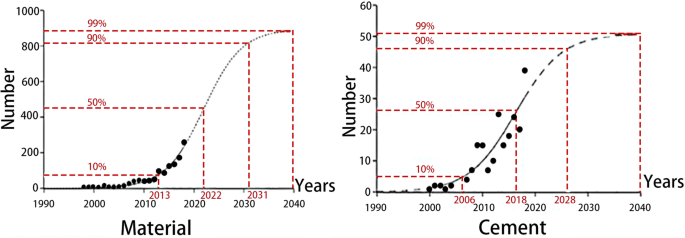
The S-curves of a different material from patents
Building material popularly used comprised of cement, concrete, gypsum, mortar compositions, and boards. Cement is widely used in building material because of its easy availability, strong hardness, excellent waterproof and fireproof performance, and low cost. The S-curve of cement is in the later period of the growth stage, which will reach 90% of the total saturation in 2028. Composite materials like Bamcrete (bamboo-concrete composite) and natural local materials like Rammed Earth had better thermal performance compared with energy-intensive materials like bricks and cement (Kandya and Mohan 2018 ). Novel bricks synthesized from fly ash and coal gangue have better advantages of energy saving in brick production phases compared with that of conventional types of bricks (Zhang et al. 2014 ). For other materials like gypsum or mortar, the numbers of patents are not enough for S-curve analysis. New-type green building materials offer an alternative way to realize energy-saving for sustainable constructions.
Energy system
The energy system mainly included a heating system and ventilation system according to the patent analysis. So, we analyzed solar power systems and air conditioning systems separately. Heat* included heat collecting panels and a fluid heating system.
The results indicated that heat*-, solar-, and ventilation-related technologies were in the growth stage which would reach 50% of the total saturation in 2022 (Fig. 16 ). Photovoltaic technology is of great importance in solar energy application (Khan and Arsalan 2016 ).
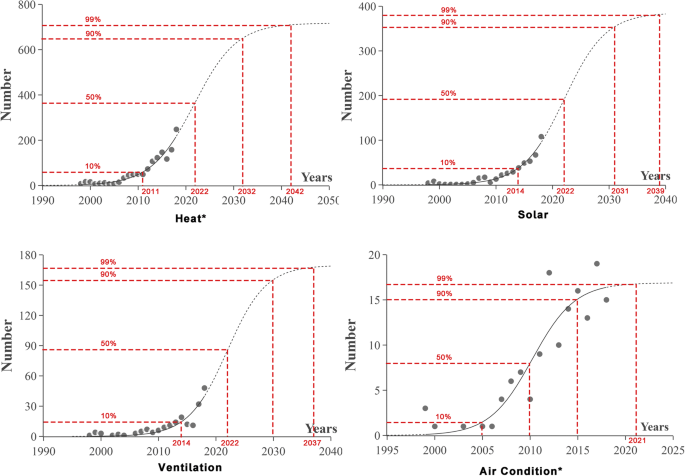
The S-curves of energy systems from patents
On the contrary, air conditioning technologies had entered into the mature stage after a decade of development. It is worth mentioning that the design of the fresh air system of buildings after the COVID-19 outbreak is much more important. With people spending the majority of their time inside (Liu et al. 2019 ), volatile organic compounds, formaldehyde, and carbon dioxide received the most attention worldwide (Wei et al. 2015 ). Due to health problems like sick building syndrome, and more recently since the COVID-19 outbreak, the supply of fresh air can drastically ameliorate indoor air quality (IAQ) (Liu et al. 2019 ). Regulating emissions from materials, enhanced ventilation, and monitoring air indoors are the main methods used in GBs for maintaining IAQ (Wei et al. 2015 ). Air circulation frequency and improved air filtration can reduce the risk of spreading certain diseases, while controlling the airflow between rooms can also prevent cross-infections. Poor indoor air quality and ventilation provide ideal conditions for the breeding and spreading of viruses by air (Chen et al. 2019 ). A diverse range of air filters coupled with a fresh air supply system should be studied. A crucial step forward is to create a cost-effective, energy-efficient, intelligent fresh air supply system (Liu et al. 2017 ) to monitor, filter outdoor PM2.5 (Chen et al. 2017 ), and saving building energy (Liu and Liu 2005 ). Earth-air heat exchanger system (EAHE) is a novel technology that supplies fresh air using underground soil heat (Chen et al. 2019 ).
A total of 5246 journal articles in English from the SCI and SSCI databases published in 1998–2018 were reviewed and analyzed. The study revealed that the literature on green buildings has grown rapidly over the past 20 years. The findings and results are summarized:
Data analysis revealed that GB research is distributed across various subject categories. Energy and Buildings, Building and Environment, Journal of Cleaner Production, and Sustainability were the top journals to publish papers on green buildings.
Global distribution was done to see the green building study worldwide, showing that the USA, China, and the UK ranked the top three countries, accounting for 14.98%, 13.29%, and 8.27% of all the publications respectively. Australia and China had the closest relationship on green building research cooperation worldwide.
Further analysis was made on countries’ characteristics, dominant issues through keyword co-occurrence, green building technology by patent analysis, and S-curve prediction. Global trends of the top 5 countries showed different characteristics. China had a steady and consistent growth in publications each year while the USA, the UK, and Italy were on a decline from 2016. The big data method was used to see the city performance in China, finding that the total publications had a high correlation with the city’s GDP and Baidu Search Index. Policies were regarded as the stimulation for green building development, either in China or the UK. Also, barriers and contradictions such as cost, occupants’ comfort, and energy consumption were discussed about the developed and developing countries.
Cluster and content analysis via CiteSpace identified popular and trending research topics at different stages of development; the top three hotspots were green buildings, sustainability, and energy efficiency throughout the whole research period. Energy efficiency has shifted from low to zero energy buildings or even beyond it in recent years. Energy efficiency was the most important drive to achieve green buildings while LCA and LEED were the two potential ways to evaluate building performance. Thermal comfort and natural ventilation of residential buildings became a topic of interest to the public.
Then, we combined the keywords with “energy” to make further patent analysis in Derwent Innovations Index. “Structure,” “material,” and “energy systems” were three of the most important types of green building technologies. According to S-curve analysis, most of the technologies of energy-saving buildings were on the fast-growing trend, and even though there were conflicts and doubts in different countries on GB adoption, it is still a promising field.
Future directions
An establishment of professional institutes or a series of policies and regulations on green building promulgated by government departments will promote research development (as described in the “Further Analysis on China, the USA, and the UK” section). Thus, a policy enacted by a formal department is of great importance in this particular field.
Passive design is important in energy saving which is ensured by strategically positioning buildings and precisely engineering the building envelope, i.e., roof, walls, windows, and floors. A quality, the passive-design house is crucial to achieving sustained thermal comfort, low-carbon footprint, and a reduced gas bill. The new insulation material is a promising field for reducing building heat loss and energy consumed. Healthy residential buildings have become a focus of future development due to people’s pursuit of a healthy life. A fresh air supply system is important for better indoor air quality and reduces the risk of transmission of several diseases. A 2020 study showed the COVID-19 virus remains viable for only 4 hours on copper compared to 24 h on cardboard. So, antiviral materials will be further studied for healthy buildings (Fezi 2020 ).
With the quick development of big data method and intelligent algorithms, artificial intelligence (AI) green buildings will be a trend. The core purpose of AI buildings is to achieve optimal operating conditions through the accurate analysis of data, collected by sensors built into green buildings. “Smart buildings” and “Connected Buildings” of the future, fitted with meters and sensors, can collect and share massive amounts of information regarding energy use, water use, indoor air quality, etc. Analyzing this data can determine relationships and patterns, and optimize the operation of buildings to save energy without compromising the quality of the indoor environment (Lazarova-Molnar and Mohamed 2019 ).
The major components of green buildings, such as building envelope, windows, and skylines, should be adjustable and versatile in order to get full use of AI. A digital control system can give self-awareness to buildings, adjusting room temperature, indoor air quality, and air cooling/heating conditions to control power consumption, and make it sustainable (Mehmood et al. 2019 ).
Concerns do exist, for example, occupant privacy, data security, robustness of design, and modeling of the AI building (Maasoumy and Sangiovanni-Vincentelli 2016 ). However, with increased data sources and highly adaptable infrastructure, AI green buildings are the future.
This examination of research conducted on green buildings between the years 1998 and 2018, through bibliometric analysis combined with other useful tools, offers a quantitative representation of studies and data conducted in the past and present, bridging historical gaps and forecasting the future of green buildings—providing valuable insight for academicians, researchers, and policy-makers alike.
Agency USEP Indoor Air Quality https://www.epa.gov/indoor-air-quality-iaq.
Ansuini R, Larghetti R, Giretti A, Lemma M (2011) Radiant floors integrated with PCM for indoor temperature control. Energy Build 43:3019–3026. https://doi.org/10.1016/j.enbuild.2011.07.018
Article Google Scholar
Bengisu M, Nekhili R (2006) Forecasting emerging technologies with the aid of science and technology databases. Technol Forecast Soc Chang 73:835–844. https://doi.org/10.1016/j.techfore.2005.09.001
Bozeman B, Fay D, Slade CP (2013) Research collaboration in universities and academic entrepreneurship: the-state-of-the-art. J Technol Transf 38:1–67. https://doi.org/10.1007/s10961-012-9281-8
Building AG Importance of Green Building. https://www.greenbuilt.org/about/importance-of-green-building
Cao XD, Dai XL, Liu JJ (2016) Building energy-consumption status worldwide and the state-of-the-art technologies for zero-energy buildings during the past decade. Energy Build 128:198–213. https://doi.org/10.1016/j.enbuild.2016.06.089
Chan APC, Darko A, Olanipekun AO, Ameyaw EE (2018) Critical barriers to green building technologies adoption in developing countries: the case of Ghana. J Clean Prod 172:1067–1079. https://doi.org/10.1016/j.jclepro.2017.10.235
Chen CC, Lo TH, Tsay YS, Lee CY, Liu KS (2017) Application of a novel formaldehyde sensor with MEMS (micro electro mechanical systems) in indoor air quality test and improvement in medical spaces. Appl Ecol Environ Res 15:81–89. https://doi.org/10.15666/aeer/1502_081089
Chen CM (2006) CiteSpace II: detecting and visualizing emerging trends and transient patterns in scientific literature. J Am Soc Inf Sci Technol 57:359–377. https://doi.org/10.1002/asi.20317
Chen X, Lu WS, Xue F, Xu JY (2018) A cost-benefit analysis of green buildings with respect to construction waste minimization using big data in Hong Kong. J Green Build 13:61–76. https://doi.org/10.3992/1943-4618.13.4.61
Chen XY, Niu RP, Lv LN, Kuang DQ, LOP (2019) Discussion on existing problems of fresh air system. In: 4th International Conference on Advances in Energy Resources and Environment Engineering, vol 237. IOP Conference Series-Earth and Environmental Science. Iop Publishing Ltd, Bristol. doi: https://doi.org/10.1088/1755-1315/237/4/042030
Chwieduk D (2003) Towards sustainable-energy buildings. Appl Energy 76:211–217. https://doi.org/10.1016/s0306-2619(03)00059-x
Communuties CotE (2002) Directive of the European parliament and the council.
Daim TU, Rueda G, Martin H, Gerdsri P (2006) Forecasting emerging technologies: use of bibliometrics and patent analysis. Technol Forecast Soc Chang 73:981–1012. https://doi.org/10.1016/j.techfore.2006.04.004
Ding GKC (2008) Sustainable construction - the role of environmental assessment tools. J Environ Manag 86:451–464. https://doi.org/10.1016/j.jenvman.2006.12.025
Doan DT, Ghaffarianhoseini A, Naismith N, Zhang TR, Ghaffarianhoseini A, Tookey J (2017) A critical comparison of green building rating systems. Build Environ 123:243–260. https://doi.org/10.1016/j.buildenv.2017.07.007
Du HB, Li BL, Brown MA, Mao GZ, Rameezdeen R, Chen H (2015) Expanding and shifting trends in carbon market research: a quantitative bibliometric study. J Clean Prod 103:104–111. https://doi.org/10.1016/j.jclepro.2014.05.094
Du HB, Liu DY, Lu ZM, Crittenden J, Mao GZ, Wang S, Zou HY (2019) Research development on sustainable urban infrastructure from 1991 to 2017: a bibliometric analysis to inform future innovations. Earth Future 7:718–733. https://doi.org/10.1029/2018ef001117
Ellabban O, Abu-Rub H, Blaabjerg F (2014) Renewable energy resources: current status, future prospects and their enabling technology. Renew Sust Energ Rev 39:748–764. https://doi.org/10.1016/j.rser.2014.07.113
Elshafei G, Negm A, Bady M, Suzuki M, Ibrahim MG (2017) Numerical and experimental investigations of the impacts of window parameters on indoor natural ventilation in a residential building. Energy Build 141:321–332. https://doi.org/10.1016/j.enbuild.2017.02.055
Ernst H (1997) The use of patent data for technological forecasting: the diffusion of CNC-technology in the machine tool industry. Small Bus Econ 9:361–381. https://doi.org/10.1023/A:1007921808138
Fezi BA (2020) Health engaged architecture in the context of COVID-19. J Green Build 15:185–212
Guozhu et al (2018) Bibliometric analysis of insights into soil remediation. J Soils Sediments 18:2520–2534
Ho S-Y (2008) Bibliometric analysis of biosorption technology in water treatment research from 1991 to 2004. Int J Environ Pollut 34:1–13. https://doi.org/10.1504/ijep.2008.020778
Article CAS Google Scholar
Hong WX, Jiang ZY, Yang Z, (2017) Iop (2017) Analysis on the restriction factors of the green building scale promotion based on DEMATEL. In: 2nd International Conference on Advances in Energy Resources and Environment Engineering, vol 59. IOP Conference Series-Earth and Environmental Science. Iop Publishing Ltd, Bristol. doi: https://doi.org/10.1088/1755-1315/59/1/012064
Hu J, Kawaguchi KI, Ma JJB (2018) Retractable membrane ceiling on indoor thermal environment of residential buildings. Build Environ 146:289–298. https://doi.org/10.1016/j.buildenv.2018.09.035
Huang N, Bai LB, Wang HL, Du Q, Shao L, Li JT (2018) Social network analysis of factors influencing green building development in China. Int J Environ Res Public Health 15:16. https://doi.org/10.3390/ijerph15122684
Huibin D, Guozhu M, Xi L, Jian Z, Linyuan W (2015) Way forward for alternative energy research: a bibliometric analysis during 1994-2013. Sustain Energy Rev 48:276–286
Jalaei F, Jrade A (2015) Integrating building information modeling (BIM) and LEED system at the conceptual design stage of sustainable buildings. Sustain Cities Soc 18(95-10718):95–107. https://doi.org/10.1016/j.scs.2015.06.007
Kandya A, Mohan M (2018) Mitigating the urban heat island effect through building envelope modifications. Energy Build 164:266–277. https://doi.org/10.1016/j.enbuild.2018.01.014
Khan J, Arsalan MH (2016) Solar power technologies for sustainable electricity generation - a review. Renew Sust Energ Rev 55:414–425. https://doi.org/10.1016/j.rser.2015.10.135
Khoshbakht et al (2018) Are green buildings more satisfactory? A review of global evidence. Habitat Int 74:57–65
Lazarova-Molnar S, Mohamed N (2019) Collaborative data analytics for smart buildings: opportunities and models. Clust Comput 22:1065–1077. https://doi.org/10.1007/s10586-017-1362-x
Li X, Wu P, Shen GQ, Wang X, Teng Y (2017) Mapping the knowledge domains of building information modeling (BIM): a bibliometric approach. Autom Constr 84:195–206. https://doi.org/10.1016/j.autcon.2017.09.011
Liu CY, Wang JC (2010) Forecasting the development of the biped robot walking technique in Japan through S-curve model analysis. Scientometrics 82:21–36
Liu GL et al (2017) A review of air filtration technologies for sustainable and healthy building ventilation. Sustain Cities Soc 32:375–396. https://doi.org/10.1016/j.scs.2017.04.011
Liu J, Liu GQ (2005) Some indoor air quality problems and measures to control them in China Indoor. Built Environ 14:75–81. https://doi.org/10.1177/1420326x05050362
Liu ZB, Li WJ, Chen YZ, Luo YQ, Zhang L (2019) Review of energy conservation technologies for fresh air supply in zero energy buildings. Appl Therm Eng 148:544–556. https://doi.org/10.1016/j.applthermaleng.2018.11.085
Liu ZJ, Pyplacz P, Ermakova M, Konev P (2020) Sustainable construction as a competitive advantage. Sustainability 12:13. https://doi.org/10.3390/su12155946
Maasoumy M, Sangiovanni-Vincentelli A (2016) Smart connected buildings design automation: foundations and trends found trends. Electron Des Autom 10:1–3. https://doi.org/10.1561/1000000043
Mao G, Zou H, Chen G, Du H, Zuo J (2015) Past, current and future of biomass energy research: a bibliometric analysis. Sustain Energy Rev 52:1823–1833. https://doi.org/10.1016/j.rser.2015.07.141
Mao GZ, Shi TT, Zhang S, Crittenden J, Guo SY, Du HB (2018) Bibliometric analysis of insights into soil remediation. J Soils Sediments 18:2520–2534. https://doi.org/10.1007/s11368-018-1932-4
Marinakis V (2020) Big data for energy management and energy-efficient buildings. Energies 13:18. https://doi.org/10.3390/en13071555
McArthur JJ, Powell C (2020) Health and wellness in commercial buildings: systematic review of sustainable building rating systems and alignment with contemporary research. Build Environ 171:18. https://doi.org/10.1016/j.buildenv.2019.106635
Mcleod RS, Hopfe CJ, Kwan A (2013) An investigation into future performance and overheating risks in Passivhaus dwellings. Build Environ 70:189–209
Mclinden D (2013) Concept maps as network data: analysis of a concept map using the methods of social network analysis. Eval Program Plann 36:40–48
Mehmood MU, Chun D, Zeeshan, Han H, Jeon G, Chen K (2019) A review of the applications of artificial intelligence and big data to buildings for energy-efficiency and a comfortable indoor living environment. Energy Build 202:13. https://doi.org/10.1016/j.enbuild.2019.109383
Miao XL, Yao Y, Wang Y, Chu YP (2011) Experimental research on the sound insulation property of lightweight composite paper honeycomb core wallboard. In: Jiang ZY, Li SQ, Zeng JM, Liao XP, Yang DG (eds) Manufacturing Process Technology, Pts 1-5, vol 189-193. Advanced Materials Research. Trans Tech Publications Ltd, Stafa-Zurich, pp 1334–1339. https://doi.org/10.4028/www.scientific.net/AMR.189-193.1334
Chapter Google Scholar
Newsham GR, Mancini S, Energy BJ (2009) Do LEED-certified buildings save energy? Yes, but…. Energy Build 41:897–905
Nguyen HT, Skitmore M, Gray M, Zhang X, Olanipekun AO (2017) Will green building development take off? An exploratory study of barriers to green building in Vietnam. Resour Conserv Recycl 127:8–20
Paul WL, Taylor PA (2008) A comparison of occupant comfort and satisfaction between a green building and a conventional building. Build Environ 43:1858–1870
Perez-Fargallo A, Rubio-Bellido C, Pulido-Arcas JA, Gallego-Maya I, Guevara-Garcia FJ (2018) Influence of adaptive comfort models on energy improvement for housing in cold areas. Sustainability 10:15. https://doi.org/10.3390/su10030859
Pongiglione M, Calderini C (2016) Sustainable structural design: comprehensive literature review. J Struct Eng 142:15. https://doi.org/10.1061/(asce)st.1943-541x.0001621
Pouris A, Pouris A (2011) Scientometrics of a pandemic: HIV/AIDS research in South Africa and the World. Scientometrics 86:541–552
Pulselli RM, Simoncini E, Pulselli FM, Bastianoni S (2007) Emergy analysis of building manufacturing, maintenance and use: Em-building indices to evaluate housing sustainability. Energy Build 39:620–628
Ruellan M, Park H, Bennacer R (2016) Residential building energy demand and thermal comfort: thermal dynamics of electrical appliances and their impact. Energy Build 130:46–54. https://doi.org/10.1016/j.enbuild.2016.07.029
Sartori I, Napolitano A, Voss K (2012) Net zero energy buildings: a consistent definition framework. Energy Build 48:220–232. https://doi.org/10.1016/j.enbuild.2012.01.032
Schossig P, Henning HM, Gschwander S, Haussmann T (2005) Micro-encapsulated phase-change materials integrated into construction materials. Solar Energy Mater Solar Cells 89:297-306
Shen C, Li XT (2016) Solar heat gain reduction of double glazing window with cooling pipes embedded in venetian blinds by utilizing natural cooling. Energy Build 112:173–183. https://doi.org/10.1016/j.enbuild.2015.11.073
Shen L, Yan H, Fan H, Wu Y, Zhang Y (2017) An integrated system of text mining technique and case-based reasoning (TM-CBR) for supporting green building design. S0360132317303797. Build Environ 124:388–401
Todd JA, Crawley D, Geissler S, Lindsey G (2001) Comparative assessment of environmental performance tools and the role of the Green Building Challenge. Build Res Inf 29:324–335
Wang H, Chiang PC, Cai Y, Li C, Wang X, Chen TL, Wei S, Huang Q (2018) Application of wall and insulation materials on green building: a review. Sustainability 10:21. https://doi.org/10.3390/su10093331
Wang J, Liu Y, Ren J, Cho S, (2017) Iop (2017) A brief comparison of existing regional green building design standards in China. In: 2nd International Conference on Advances in Energy Resources and Environment Engineering, vol 59. IOP Conference Series-Earth and Environmental Science. Iop Publishing Ltd, Bristol. doi: https://doi.org/10.1088/1755-1315/59/1/012013
Wei WJ, Ramalho O, Mandin C (2015) Indoor air quality requirements in green building certifications. Build Environ 92:10–19. https://doi.org/10.1016/j.buildenv.2015.03.035
Wuni IY, Shen GQP, Osei-Kyei R (2019a) Scientometric review of global research trends on green buildings in construction journals from 1992 to 2018. Energy Build 190:69–85
Wuni IY, Shen GQP, Osei RO (2019b) Scientometric review of global research trends on green buildings in construction journals from 1992 to 2018 Energy Build 190:69-85 doi: https://doi.org/10.1016/j.enbuild.2019.02.010
Yang XD, Zhang JY, Zhao XB (2018) Factors affecting green residential building development: social network analysis. Sustainability 10:21. https://doi.org/10.3390/su10051389
Ye L, Cheng Z, Wang Q, Lin H, Lin C, Liu B (2015) Developments of Green Building Standards in China. Renew Energy 73:115–122
Ye Q, Li T, Law R (2013) A coauthorship network analysis of tourism and hospitality research collaboration. J Hosp Tour Res 37:51–76
Yoon B, Park Y (2004) A text-mining-based patent network: analytical tool for high-technology trend. J High Technol Manag Res 15:37–50
Yuan XL, Wang XJ, Zuo J (2013) Renewable energy in buildings in China-a review. Renew Sust Energ Rev 24:1–8. https://doi.org/10.1016/j.rser.2013.03.022
Zhang HT, Hu D, Wang RS, Zhang Y (2014) Urban energy saving and carbon reduction potential of new-types of building materials by recycling coal mining wastes. Environ Eng Manag J 13:135–144
Zhang HZ, Li H, Huang BR, Destech Publicat I (2015) Development of biogas industry in Beijing. 2015 4th International Conference on Energy and Environmental Protection. Destech Publications, Inc, Lancaster
Zhang SF, Andrews-Speed P, Zhao XL, He YX (2013) Interactions between renewable energy policy and renewable energy industrial policy: a critical analysis of China’s policy approach to renewable energies. Energy Policy 62:342–353. https://doi.org/10.1016/j.enpol.2013.07.063
Zhang Y, Huang K, Yu YJ, Yang BB (2017) Mapping of water footprint research: a bibliometric analysis during 2006-2015. J Clean Prod 149:70–79. https://doi.org/10.1016/j.jclepro.2017.02.067
Zhang Y, Kang J, Jin H (2018) A review of Green Building Development in China from the perspective of energy saving. Energies 11:18. https://doi.org/10.3390/en11020334
Zhao XB, Zuo J, Wu GD, Huang C (2019) A bibliometric review of green building research 2000-2016. Archit Sci Rev 62:74–88. https://doi.org/10.1080/00038628.2018.1485548
Zuo J, Zhao ZY (2014) Green building research-current status and future agenda: a review. Renew Sust Energ Rev 30:271–281. https://doi.org/10.1016/j.rser.2013.10.021
Download references
Availability of data and materials
The datasets generated and analyzed throughout the current study are available in the Web of Science Core Collection.
This study was supported by The National Natural Science Foundation of China (No.51808385).
Author information
Authors and affiliations.
School of Environmental Science and Engineering, Tianjin University, No. 135 Yaguan Road, Tianjin, 300350, China
Li Ying, Rong Yanyu, Umme Marium Ahmad, Wang Xiaotong & Mao Guozhu
Tianjin University Research Institute of Architectural Design and Urban Planning Co., Ltd, Tianjin, 300072, China
Center for Green Buildings and Sponge Cities, Georgia Tech Tianjin University Shenzhen Institute, Shenzhen, 518071, Guangdong, China
Rong Yanyu, Wang Xiaotong & Mao Guozhu
School of Architecture & Built Environment, The University of Adelaide, Adelaide, Australia
You can also search for this author in PubMed Google Scholar
Contributions
Ying Li conceived the frame of the paper and wrote the manuscript. Yanyu Rong made the data figures and participated in writing the manuscript. Umme Marium Ahmad helped with revising the language. Xiaotong Wang consulted related literature for the manuscript. Jian Zuo contributed significantly to provide the keywords list. Guozhu Mao helped with constructive suggestions.
Corresponding author
Correspondence to Rong Yanyu .
Ethics declarations
Ethics approval and consent to participate.
This manuscript is ethical.
Consent for publication
Not applicable.
Competing interest
The authors declare no competing interest.
Additional information
Responsible Editor: Philippe Garrigues
Publisher’s Note
Springer Nature remains neutral with regard to jurisdictional claims in published maps and institutional affiliations.
Supplementary Information
(DOCX 176 kb)
(From Web of Science Core Collection)
Topic: (“bioclimatic architect*” or “bioclimatic build*” or “bioclimatic construct*” or “bioclimatic hous*” or “eco-architect*” or “eco-build*” or “eco-home*” or “eco-hous*” or “eco-friendly build*” or “ecological architect*” or “ecological build*” or “ecological hous*” or “energy efficient architect*” or “energy efficient build*” or “energy efficient construct*” or “energy efficient home*” or “energy efficient hous*” or “energy efficient struct*” or “energy saving architect*” or “energy saving build*” or “energy saving construct*” or “energy saving home*” or “energy saving hous*” or “energy saving struct*” or “green architect*” or “green build*” or “green construct*” or “green home*” or “low carbon architect*” or “low carbon build*” or “low carbon construct*” or “low carbon home*” or “low carbon hous*” or “low energy architect*” or “low energy build*” or “low energy construct*” or “low energy home*” or “low energy hous*” or “sustainable architect*” or “sustainable build*” or “sustainable construct*” or “sustainable home*” or “sustainable hous*” or “zero energy build*” or “zero energy home*” or “zero energy hous*” or “net zero energy build*” or “net zero energy home*” or “net zero energy hous*” or “zero-carbon build*” or “zero-carbon home*” or “zero-carbon hous*” or “carbon neutral build*” or “carbon neutral construct*” or “carbon neutral hous*” or “high performance architect*” or “high performance build*” or “high performance construct*” or “high performance home*” or “high performance hous*”)
Time span: 1998-2018。 Index: SCI-EXPANDED, SSCI。
Rights and permissions
Reprints and permissions
About this article
Li, Y., Rong, Y., Ahmad, U.M. et al. A comprehensive review on green buildings research: bibliometric analysis during 1998–2018. Environ Sci Pollut Res 28 , 46196–46214 (2021). https://doi.org/10.1007/s11356-021-12739-7
Download citation
Received : 18 October 2020
Accepted : 26 January 2021
Published : 16 February 2021
Issue Date : September 2021
DOI : https://doi.org/10.1007/s11356-021-12739-7
Share this article
Anyone you share the following link with will be able to read this content:
Sorry, a shareable link is not currently available for this article.
Provided by the Springer Nature SharedIt content-sharing initiative
- Green buildings
- Bibliometric analysis
- Energy efficiency
- Find a journal
- Publish with us
- Track your research

Importance of Green Building
What is green building.
Green building, or sustainable design, is the practice of increasing the energy, water, and material efficiency of our buildings and their sites. Green building benefits our communities by reducing impacts on human health and the environment. Green-building concepts extend beyond the walls of buildings and include site planning, community and land-use planning issues as well. Green practices are environmentally responsible and resource-efficient throughout the design and development of homes and business buildings. Green building comes with the same durability and longevity as traditional building.
Why is green building important?
The growth and development of our communities has a large impact on our natural environment. Manufacturing, design, construction and operation of buildings are responsible for the consumption of many of our natural resources, so maximizing efficiency and sustainability in this industry is essential to our community well-being.
From the siting process to design implementation, including maintenance and deconstruction, Green Built Alliance works diligently to enhance the communities well-being.
Who is Green Built Alliance?
Learn how the work of Green Built Alliance helps to advance the green building movement.
In the United States, buildings account for:
- 39% of total energy use
- 68% of total electricity consumption
- 30% of landfill waste
- 38% of carbon dioxide emissions
- 12% of total water consumption
Environmental benefits of green building:
- Enhance and protect biodiversity and ecosystems
- Improve air and water quality
- Reduce waste streams
- Conserve and restore natural resources
Economic benefits of green building:
- Reduce operating costs
- Improve occupant productivity
- Enhance asset value and profits
- Optimize life-cycle economic performance
Social benefits of green building:
- Enhance occupant health and comfort
- Improve indoor air quality
- Minimize strain on local utility infrastructure
- Improve overall quality of life
Statistics and benefits overview courtesy of the U.S. Environmental Protection Agency .
Green Building Programs
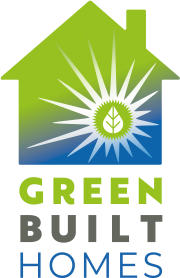
Green Built Homes Certification Program
A NC statewide residential green building rating program administered by the Green Built Alliance. Homes receive a rating and certificate based on third-party inspections.

Leadership in Energy and Environmental Design (LEED) Rating System
A nationally accepted rating system for commercial and institutional buildings. The program helps establish a standard measurement for green building.
Green Building Resources
We host a wealth of materials to support you in green building. Our Resource Library offers many links to resources by category and our Magazine/Directory offers an annual publication with useful articles written by our members and staff.

Presentations made painless
- Get Premium
112 Green Building Essay Topic Ideas & Examples
Inside This Article
Green building is a growing trend in the construction industry as more and more people become aware of the importance of sustainability and environmental conservation. If you are a student studying architecture, engineering, or any related field, you may be tasked with writing an essay on green building. To help you get started, here are 112 green building essay topic ideas and examples:
- The impact of green buildings on the environment
- The benefits of green building certification programs
- The role of sustainable materials in green building
- Energy-efficient design principles in green buildings
- The use of renewable energy sources in green buildings
- The economics of green building
- Green building policies and regulations
- Green building case studies in different regions
- The future of green building technology
- Green building practices in developing countries
- Green building vs traditional construction methods
- The importance of indoor air quality in green buildings
- The impact of green building on human health
- Green building and urban planning
- The social benefits of green building
- The role of architects in promoting green building
- The challenges of implementing green building practices
- Green building and climate change mitigation
- Green building and disaster resilience
- Green building and water conservation
- The role of green roofs in green building
- Green building and waste management
- The impact of green building on property values
- Green building and sustainable development goals
- The role of green building in carbon neutrality
- Green building and biodiversity conservation
- The psychology of green building design
- Green building and community engagement
- The role of green building in reducing greenhouse gas emissions
- Green building and energy poverty
- The impact of green building on construction industry jobs
- Green building and affordable housing
- The role of green building in disaster recovery
- Green building and cultural heritage preservation
- Green building and historic preservation
- The role of green building in reducing urban heat island effect
- Green building and transportation planning
- The impact of green building on urban agriculture
- Green building and social equity
- The role of green building in reducing water pollution
- Green building and sustainable tourism
- The impact of green building on public health
- Green building and sustainable transportation
- The role of green building in reducing food insecurity
- Green building and sustainable forestry
- The impact of green building on wildlife conservation
- Green building and sustainable fisheries
- The role of green building in reducing plastic pollution
- Green building and sustainable waste management
- The impact of green building on climate adaptation
- Green building and sustainable energy access
- The role of green building in reducing soil erosion
- Green building and sustainable agriculture
- The impact of green building on marine conservation
- Green building and sustainable fisheries management
- The role of green building in reducing air pollution
- Green building and sustainable water management
- The impact of green building on biodiversity conservation
- Green building and sustainable land use planning
- The role of green building in reducing habitat destruction
- Green building and sustainable fisheries conservation
- The impact of green building on sustainable forestry
- Green building and sustainable agriculture practices
- The role of green building in reducing water scarcity
- Green building and sustainable energy production
- The impact of green building on sustainable transportation
- Green building and sustainable waste disposal
- Green building and sustainable land management
- The impact of green building on sustainable water resources
- Green building and sustainable energy consumption
- The role of green building in reducing energy poverty
- Green building and sustainable agriculture production
- The impact of green building on sustainable fisheries
- Green building and sustainable forestry practices
- Green building and sustainable land use management
- The impact of green building on sustainable water supply
- Green building and sustainable energy efficiency
- Green building and sustainable waste management practices
- The impact of green building on sustainable transportation systems
- Green building and sustainable land conservation
- Green building and sustainable fisheries management practices
- The impact of green building on sustainable forestry practices
- Green building and sustainable agriculture management
- Green building and sustainable energy production practices
- Green building and sustainable waste disposal practices
- The role of green building in reducing greenhouse gas
Want to create a presentation now?
Instantly Create A Deck
Let PitchGrade do this for me
Hassle Free
We will create your text and designs for you. Sit back and relax while we do the work.
Explore More Content
- Privacy Policy
- Terms of Service
© 2023 Pitchgrade
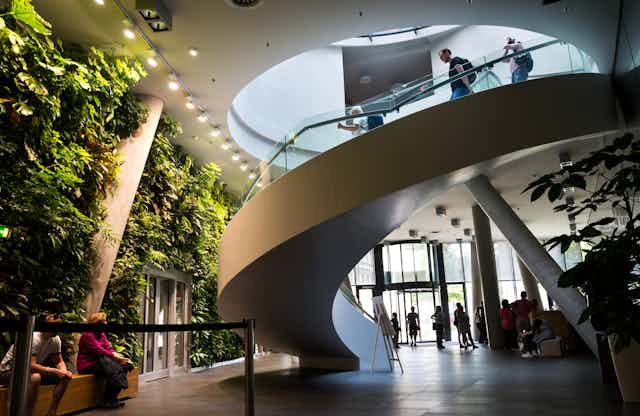
Green buildings can boost productivity, well-being and health of workers
PhD Candidate, Bioresource Engineering, McGill University
Disclosure statement
Md Sazan Rahman receives Schulish Fellowship from Graduate and Postdoctoral Studies - McGill University, and Doctoral research scholarships from Fonds de recherche du Québec -Nature et Technologies (FRQ-NT).
McGill University provides funding as a member of The Conversation CA.
McGill University provides funding as a member of The Conversation CA-FR.
View all partners
Most people now recognize the energy savings benefits of green buildings. These buildings use less water, energy and other natural resources. In some cases, they can increase biodiversity, produce their own energy and reduce the urban heat island effect .
Recent research shows that green buildings can also improve the health and productivity of those who live or work inside them. In some cases, green buildings can have the same benefits as spending time in nature, which can benefit people living in cold climates.
Green buildings cost five to 10 per cent more than a conventional buildings . Some planners might worry about the added design and construction costs of a green building. But detailed analyses show that the small increase in building costs has noticeable benefits on the health and wellness of those working or living inside the building — or nearby.
Energy savings
Buildings with green roofs, green walls, green interior decoration or those surrounded by green infrastructure are all considered to be green buildings. These buildings usually contain algae, grass, herbs, vegetables or other leafy green or micro-green plants on their interior or exterior surfaces.
Covering the roof of an uninsulated building with plants reduces the amount of energy used in heating by up to five per cent in the winter , and the cooling energy by as much as 33 per cent in summer, which saves money. It also reduces daytime indoor temperature fluctuations in the absence of air conditioning.
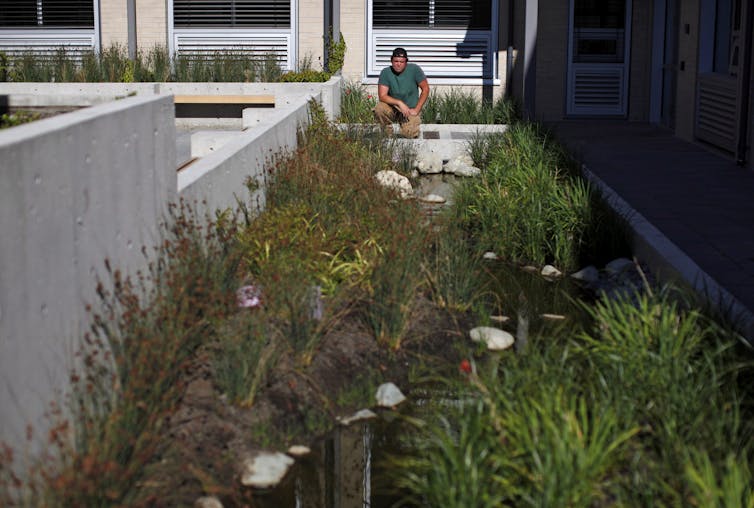
Cities often have warmer air temperatures than the rural areas around them because their dark surfaces absorb the sun’s rays and radiate the heat. Green buildings can help reduce this urban heat island effect.
Computer modelling has shown that summer temperatures can be reduced by 2 C if seven per cent of an urban rooftop is green . Even in relatively colder cities like Toronto or New York, covering 50 per cent of the roof with plants could reduce the local temperature by about 1 C in the summer .
This dip in temperature comes with numerous benefits. Studies show people working or living in areas with high proportions of green roofs have better mental health, heal more quickly after an illness and are more productive at work .
Improved air quality
Indoor air pollution is one of the top five environmental risks to public health , according to the U.S. Environmental Protection Agency. High levels of sulfur dioxide, nitrogen dioxide, PM10 (particulate matter with a diameter of 10 microns or less) and airborne microbes can contribute to serious respiratory illness.
A 20 per cent increase in the surface area of green roofs and walls in downtown Toronto could meaningfully reduce the air levels of nitrogen dioxide, ozone, sulfur dioxide and PM10, and generate a savings of US$190,000 annually in terms of pollution removal.
One study showed that there were fewer mould spores and microbes in a room where houseplants covered one-third of the floor space compared to a room with no house plants. Plants also increase indoor humidity levels in dry climates, reducing the likelihood of dry eyes, itchy or scratchy throat or chapped lips .
Faster recoveries
Recent research has also shown that plants can help hospitalized patients heal faster .
A report by the Green Building Council of Australia found that hospitals with green infrastructure, such as an ornamental green wall, plants on every balcony and large trees around the building, reduced average hospital stays by 8.5 per cent, sped up recovery time by 15 per cent, reduced the rate of secondary infections by 11 per cent and lowered the need of pain medication by 22 per cent .
Not only do buildings with plants help patients heal faster, but they also energize the doctors, nurses and other staff who work there, and provide esthetic, acoustic and air quality benefits .

Lower emissions
Interior spaces with green walls, vertical gardens or potted plants can reduce noise levels , which helps occupants concentrate on their work. Outdoor permeable surfaces, such as soil, rock wool and vermiculite, and plants on buildings’ roofs and courtyards reduce echos .
Green workplaces meet all the criteria of the “triple bottom line,” summarized as “people, planet and profit.” These improve the health and well-being of people, improve energy efficiency and boost productivity.
Green infrastructure has clear climate benefits too. A study by the Green Building Council of Australia found that by adding green walls, roofs and other low-energy interventions, such as using LED lights, adding more windows to increase the amount of daylight and modifying ventilation systems to recover heat rather than expelling it outside, a green certified building produces 62 per cent fewer greenhouse gas emissions than an average Australian building .
It’s high time green buildings became the norm to improve well-being, air quality and carbon emissions.
- Energy efficiency
- Air pollution
- Green walls
- Green roofs
- Urban heat islands
- Green buildings

Head, School of Psychology

Senior Lecturer (ED) Ballarat

Senior Research Fellow - Women's Health Services

Lecturer / Senior Lecturer - Marketing

Assistant Editor - 1 year cadetship

Sustainably Forward
5 Advantages of Green Buildings: Benefits and Examples
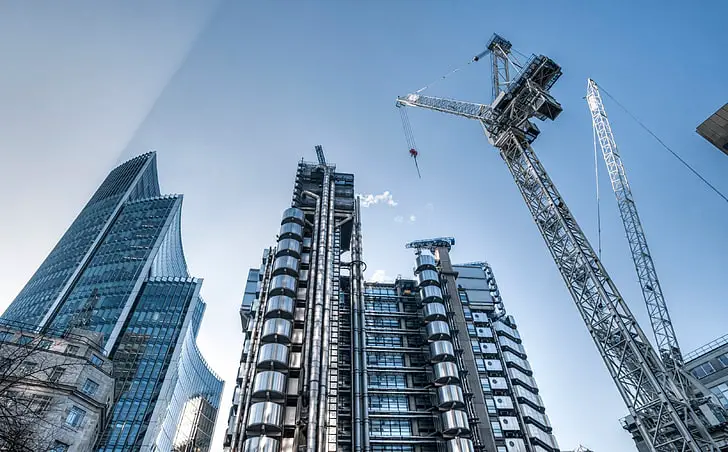
Discover the advantages of green buildings! Dive into how they benefit our environment, economy, and health and explore future trends and real-world examples.
Imagine living or working in a space that not only benefits your health and wallet but also the planet. Sounds fantastic, right?
Welcome to the world of green buildings! The advantages of green buildings stretch far beyond the usual bricks and mortar.
They offer a unique blend of economic, environmental, and social benefits that are transforming our built environment.
Let’s delve into this fascinating world and uncover the myriad benefits that green buildings bring to our lives and our future generations.
Advantages of Green Buildings
Table of Contents
Ever wondered how a building could be more than just walls, floors, and a roof?
In this post, we’re going to explore the advantages of green buildings, structures that go the extra mile.
We’ll delve into how they’re not only designed to look good, but also to reduce environmental impact, save money, and promote healthier living.
From their environmental benefits to their economic perks, from their contribution to our health to their efficient use of materials, we’ll cover it all.
We’ll also share some inspiring case studies, address common misconceptions, and look at what the future holds for green buildings.
So, let’s embark on this journey to understand how green buildings are reshaping our world.
Definition of Green Buildings
So, what exactly are green buildings? Well, they’re not just structures painted green!
Green buildings, also known as sustainable buildings, are designed and constructed with a focus on efficiency and minimal impact on the environment.
They incorporate practices that reduce carbon footprint, reduce energy consumption, improve water efficiency, utilize sustainable building materials, and promote better indoor air quality.
From the environmental design phase to construction materials, and even during their operation, green buildings aim to respect and work with the environment, rather than against it.
They’re like a breath of fresh air in the world of green architecture and green construction methods!
Importance of Green Buildings
Now, you might be wondering, why all the fuss about green buildings?
The importance of green buildings lies in their numerous benefits that extend beyond the building itself.
For starters, they play a significant role in tackling climate change.
With traditional buildings accounting for a substantial portion of global energy use and greenhouse gas emissions, green buildings offer a way to reduce this impact for building owners.
They’re like the superheroes of the building world, battling against climate change one building at a time!
But the benefits don’t stop at the environment. Green buildings also make economic sense.
They can lead to significant cost savings over time through reduced energy and water usage.
Plus, they often have higher property values compared to conventional commercial buildings.
And let’s not forget about the people living or working in these buildings.
Green buildings provide healthier and more comfortable spaces for occupants.
They’re designed to maximize natural light, improve air quality, and even reduce noise levels.
In a nutshell, green buildings are a win-win-win, for the environment, for the economy, and for people. And that’s why they’re so important.
Now that we’ve defined what green buildings are and why they’re so important, let’s dive deeper into their advantages.
These eco-friendly structures are packed with benefits that truly make them stand out in the world of architecture.
From their positive impact on the environment to their economic benefits and their contribution to our health and well-being, green buildings are truly a game-changer.
They also champion the use of sustainable and efficient materials, making them a beacon of sustainability in our built environment.
So, let’s unpack these advantages and see how green buildings are making a difference in our world.
Environmental Benefits
Reduction in Energy Usage: One of the standout features of green buildings is their ability to significantly reduce energy usage.
How do they do this? Through smart design and the use of energy-efficient technologies.
For instance, green buildings often incorporate natural light to reduce the need for artificial lighting.
They also use energy-efficient appliances and systems, like LED lighting and high-efficiency HVAC systems. It’s like putting your building on an energy diet!
Lower Greenhouse Gas Emissions: By reducing energy usage, green buildings also help to lower greenhouse gas emissions.
Think of it as your building doing its part to fight climate change. It’s like each green building is a small but significant soldier in the battle against global warming.
Water Efficiency: Green buildings don’t just shine in energy efficiency; they’re also champions of water efficiency.
They often incorporate features like low-flow fixtures, rainwater harvesting systems, and greywater recycling.
These features help to reduce water usage and make the most of every drop.
It’s like giving your building a lesson in water conservation!
Economic Benefits
Cost Savings: While green buildings might have higher upfront costs, they can lead to significant cost savings in the long run.
Thanks to their energy and water efficiency, green buildings can help to reduce utility bills.
It’s like your building is not just eco-friendly, but also wallet-friendly!
Increased Property Value: Green buildings often have higher property values compared to conventional buildings.
This is because more and more people are recognizing the benefits of green buildings and are willing to pay a premium for them.
It’s like your green building is not just a building, but also a smart investment!
Higher Return on Investment: With their cost savings and increased property values, green buildings often offer a higher return on investment compared to conventional buildings.
So, investing in a green building is not just good for the planet, but also for your pocket!
Health and Social Benefits
Improved Indoor Air Quality: Green buildings are designed to promote better indoor air quality.
They do this through the use of non-toxic materials and improved ventilation. It’s like your building is looking out for your health!
Enhanced Occupant Comfort and Health: Green buildings also focus on providing a comfortable and healthy environment for occupants.
They do this through features like natural light, temperature control, and noise reduction.
It’s like your building is designed to keep you happy and healthy!
Increased Productivity: Believe it or not, green buildings can even help to boost productivity.
Studies have shown that people are more productive in environments with good air quality, comfortable temperatures, and natural light which are all features of green buildings.
It’s like your building is your secret weapon for getting more done!
Sustainable and Efficient Material Use
Use of Recycled and Upcycled Materials: Green buildings often make use of recycled and upcycled materials.
This helps to reduce the demand for new materials and reduces waste. It’s like your building is part of the recycling revolution!
Durability and Longevity of Green Materials: Green materials are not just eco-friendly, but they’re often also more durable and longer-lasting than conventional materials.
This means that green buildings can stand the test of time. It’s like your building is built to last!
Case Studies of Green Buildings
Now that we’ve explored the myriad advantages of green buildings, let’s bring these benefits to life with some real-world examples.
In this section, we’ll take a look at some standout green buildings from around the world.
These case studies will not only illustrate the benefits we’ve discussed but also showcase the innovative design and construction practices that make these buildings so remarkable.
We’ll also delve into the lessons learned and best practices gleaned from these projects.
So, get ready to be inspired by how green buildings are making a difference in communities around the globe!
Examples of Successful Green Buildings
Let’s take a virtual tour of some successful green buildings that have made a mark in the world of sustainable architecture.
The Edge, Amsterdam:
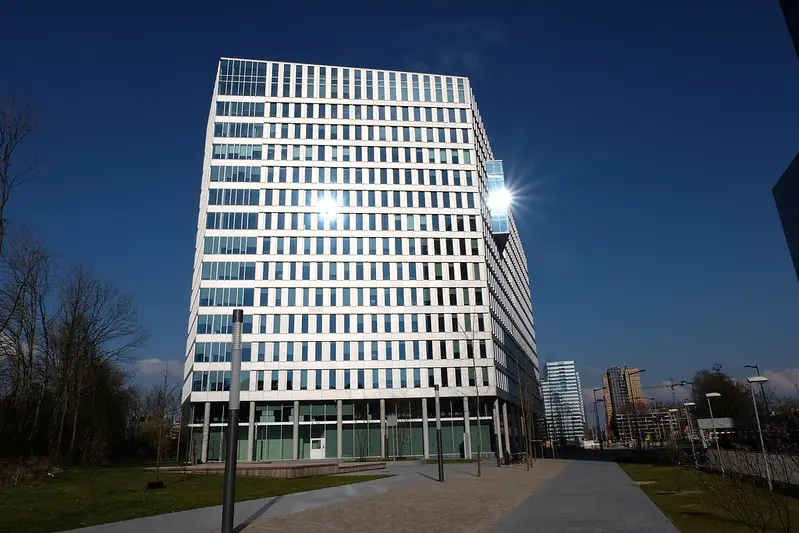
Known as the greenest office building in the world, The Edge in Amsterdam is a shining example of sustainability.
It boasts a BREEAM score of 98.36%, the highest ever awarded.
The building uses a range of smart technologies, including a connected lighting system that not only reduces energy usage but also provides data on occupancy and usage patterns.
It’s like the building itself is a living, breathing entity!
Bullitt Center, Seattle:

Dubbed the greenest commercial building in the world, the Bullitt Center in Seattle is a marvel of sustainable design.
It’s a net-zero energy building, meaning it produces as much energy as it uses, thanks to a large solar panel array on its roof.
The building also features a rainwater collection system and composting toilets. It’s like the building is a self-sustaining ecosystem!
Lessons Learned and Best Practices
From these and other successful green buildings, we can glean some valuable lessons and best practices.
Integrated Design Process: One key lesson is the importance of an integrated design process.
This means bringing together all stakeholders, including architects, engineers, and occupants, from the early stages of design.
This collaborative approach ensures that all aspects of sustainability are considered and integrated into the building design.
It’s like having a team huddle before the big game!
Focus on Occupant Comfort: Another important lesson is the focus on occupant comfort.
Green buildings are not just about reducing environmental impact; they’re also about creating healthy and comfortable spaces for people.
This means considering factors like natural light, air quality, and thermal comfort in the design. It’s like designing a building with a big heart!
Long-term Perspective: Lastly, successful green buildings take a long-term perspective.
While they might have higher upfront costs, the long-term benefits in terms of energy savings, human health benefits, and environmental impact make them a smart investment.
It’s like planting a seed and nurturing it to grow into a mighty tree!
Challenges and Misconceptions about Green Buildings
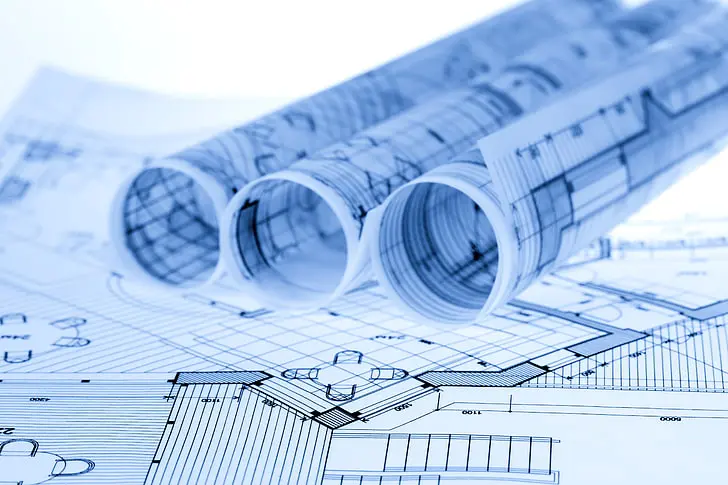
While green buildings offer a host of benefits, they’re not without their challenges and misconceptions.
In this section, we’ll address some of the common hurdles and misunderstandings that often come up when discussing green buildings.
From concerns about higher initial costs to misconceptions about performance and comfort, we’ll tackle these issues head-on.
We’ll also discuss the need for specialized knowledge and skills in the field of green building.
So, let’s dive in and debunk some myths while shedding light on the realities of green building.
Higher Initial Costs
One of the most common challenges associated with green buildings is the perception of higher initial costs.
It’s true that sustainable materials and technologies can sometimes come with a higher price tag upfront.
However, it’s important to consider the bigger picture. While the initial investment might be higher, the long-term savings in energy and water costs can more than makeup for it.
It’s like buying a car with better gas mileage where you might pay more upfront, but you’ll save money at the pump over the long run!

Misconceptions about Performance and Comfort
Another common misconception about green buildings is that they compromise on performance and comfort.
Some people believe that energy-efficient buildings might be darker or less comfortable. But that’s not the case!
Green buildings are designed to be just as comfortable, if not more so, than conventional buildings.
They use natural light, improve air quality, and maintain comfortable temperatures.
It’s like living in a home that’s not just good for the environment, but also good for you!
Need for Specialized Knowledge and Skills
Building green requires a certain level of specialized knowledge and skills.
From understanding sustainable materials to knowing how to design for energy efficiency, it’s a field that requires expertise.
This can sometimes be a barrier, as there might be a lack of trained professionals in some areas.
However, with the growing interest in sustainability, more and more professionals are gaining the skills needed to design and construct green buildings.
It’s like a new wave of builders and architects, armed with the knowledge to build a more sustainable future!
Future of Green Buildings
As we look toward the horizon, what does the future hold for green buildings?
In this section, we’ll explore the exciting trends and innovations shaping the future of sustainable architecture.
We’ll also delve into the crucial role green buildings will play in sustainable development.
From new materials and technologies to changing attitudes and policies, the future of green buildings is bright and full of potential.
So, let’s journey into the future and see how green buildings will continue to evolve and make our world a better place.
Trends and Innovations in Green Building Design
As we step into the future, several exciting trends and innovations are shaping the world of green building design.
Smart Buildings: One of the biggest trends is the rise of smart buildings.
These buildings use advanced technology to monitor and control various systems, including heating, lighting, and security.
This not only improves efficiency but also enhances the comfort and safety of occupants. It’s like your building has a brain of its own!
Biophilic Design: Another trend is biophilic design, which involves incorporating elements of nature into the built environment.
This can include things like living walls, indoor gardens, and natural materials.
Research shows that biophilic design can improve well-being and productivity. It’s like bringing a piece of the great outdoors inside!
Net-Zero Energy Buildings: We’re also seeing a rise in net-zero energy buildings.
These are buildings that produce as much energy as they consume, usually through renewable energy sources like solar panels or wind turbines.
It’s like your building is a self-sustaining island of energy efficiency!
Role of Green Buildings in Sustainable Development
Green buildings play a crucial role in sustainable development.
They’re a key part of the solution to many of the challenges we face, from climate change to resource depletion.
Reducing Environmental Impact: By reducing energy and water consumption, and by using sustainable materials, green buildings help to lessen our impact on the environment.
It’s like each green building is a small step towards a more sustainable planet!
Promoting Health and Well-being: Green buildings also promote health and well-being.
By improving air quality, increasing natural light, and creating comfortable spaces, they contribute to healthier and happier communities.
It’s like your building is looking out for your well-being!
Economic Sustainability: Lastly, green buildings contribute to economic sustainability.
They can lead to cost savings, create jobs, and contribute to a more resilient economy.
It’s like your building is not just a building, but also a driver of sustainable development!
As we’ve journeyed through the world of green buildings, you might have a few questions brewing. Well, you’re not alone!
In this section, we’ll tackle some of the most frequently asked questions about green buildings.
From understanding the main elements of a green building to exploring how they contribute to cost savings and health benefits, we’ve got you covered.
We’ll even delve into the future benefits of green buildings. So, let’s dive into these FAQs and quench your curiosity about green buildings.
Q: What are the main elements of a green building?
A: Great question! The main elements of a green building typically include energy efficiency, water efficiency, the use of sustainable materials, and a focus on indoor environmental quality.
This means they’re designed to reduce energy and water consumption, use materials that have a low impact on the environment, and provide a healthy and comfortable environment for occupants.
It’s like the building is designed with both the planet and its people in mind!
Q: How does a green building contribute to cost savings?
A: Green buildings contribute to cost savings primarily through reduced energy and water usage.
By using energy-efficient technologies and water-saving features, green buildings can significantly lower utility bills.
Plus, the use of durable and low-maintenance materials can lower maintenance costs.
Q: What are the health benefits of living or working in a green building?
A: Living or working in a green building can offer numerous health benefits.
These buildings are designed to improve indoor air quality, maximize natural light, and maintain comfortable temperatures.
This can lead to improved comfort, reduced risk of illness, and even increased productivity.
It’s like your building is looking out for your health and well-being!
Q: What are the benefits of green building in the future?
A: Looking to the future, green buildings will play a crucial role in tackling climate change, promoting sustainable development, and creating healthier communities.
They’ll help to reduce greenhouse gas emissions, conserve natural resources, and create comfortable and healthy spaces for people.
Plus, as more and more people recognize the benefits of green buildings, they’ll become increasingly popular, leading to a more sustainable and resilient built environment.
It’s like green buildings are paving the way for a brighter future!
As we wrap up our deep dive into the world of green buildings, it’s clear that these sustainable structures offer a host of benefits, from environmental to economic to health.
But more than that, they represent a shift in how we think about our built environment.
In this conclusion, we’ll recap the importance and benefits of green buildings and make a call to action for more adoption of green building practices.
So, let’s take a moment to reflect on what we’ve learned and consider how we can all play a part in promoting a more sustainable future.
Recap of the Importance and Benefits of Green Buildings
As we look back on our journey through the world of green buildings, it’s clear that these structures are more than just buildings.
They’re a testament to our ability to create spaces that are not only functional and beautiful but also kind to our planet and beneficial to our health and well-being.
From their impressive environmental benefits, like reduced energy usage and lower greenhouse gas emissions, to their economic advantages, such as cost savings and increased property value, green buildings truly stand out.
And let’s not forget their contribution to our health and social well-being, offering improved indoor air quality, enhanced comfort, and increased productivity.
Plus, their focus on sustainable and efficient material use sets a new standard for the building industry.
It’s like we’ve discovered a new blueprint for building that’s better for us and for our planet!
Call to Action for More Adoption of Green Building Practices
But understanding the importance and benefits of green buildings is just the first step.
Now, it’s time for action. Whether you’re a builder, architect, property owner, or just someone who cares about the environment, we all have a role to play in promoting the adoption of green building practices.
This could mean choosing to live or work in a green building, incorporating green building practices into your own projects, or advocating for policies that support a sustainable construction industry.
Remember, every green building makes a difference. So, let’s take what we’ve learned and use it to create a more sustainable future.
It’s like we’re all architects, designing a better world one green building at a time!
Related Posts:
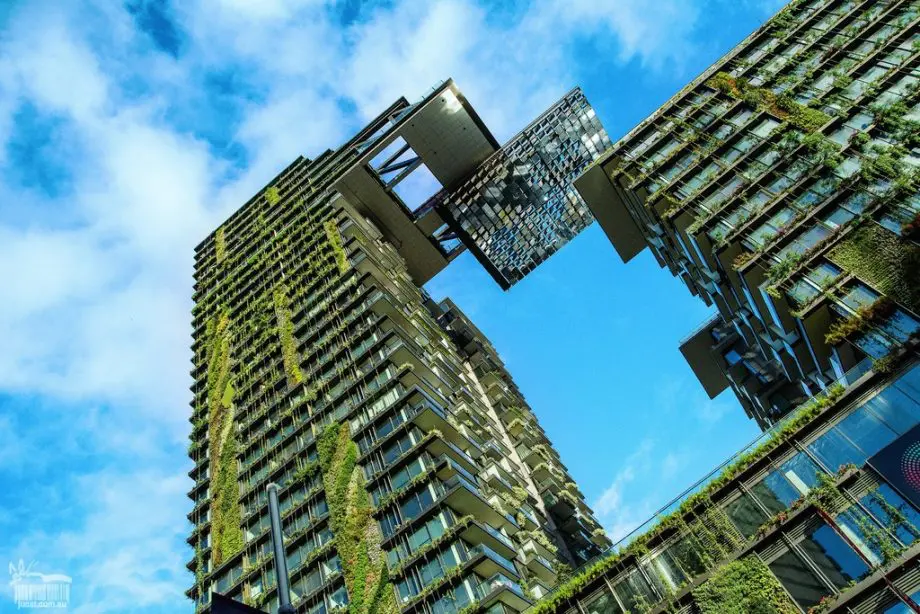
Home — Essay Samples — Environment — Green Building — Eco-Friendly Buildings and the Benefits
Eco-friendly Buildings and The Benefits
- Categories: Green Building
About this sample

Words: 3047 |
16 min read
Published: Apr 11, 2019
Words: 3047 | Pages: 7 | 16 min read

Cite this Essay
Let us write you an essay from scratch
- 450+ experts on 30 subjects ready to help
- Custom essay delivered in as few as 3 hours
Get high-quality help

Dr. Karlyna PhD
Verified writer
- Expert in: Environment

+ 120 experts online
By clicking “Check Writers’ Offers”, you agree to our terms of service and privacy policy . We’ll occasionally send you promo and account related email
No need to pay just yet!
Related Essays
2 pages / 942 words
3 pages / 1670 words
2 pages / 742 words
2 pages / 804 words
Remember! This is just a sample.
You can get your custom paper by one of our expert writers.
121 writers online
Still can’t find what you need?
Browse our vast selection of original essay samples, each expertly formatted and styled
Related Essays on Green Building
Green buildings are created to build a structure that is environmentally friendly and energy-efficient over its life cycle, which is surely essential in the construction industry. The question about effectiveness of Green [...]
The construction industry plays a pivotal role in shaping the economic landscape of Tanzania, encompassing a wide array of sectors ranging from transportation infrastructure and real estate to civil works such as water supply [...]
Biofuels are intended to replace gas, diesel fuel, and coal, which are called "petroleum products" since they are produced using creatures and plants, that passed on a large number of years ago. Using Biofuel is one of the ways [...]
The Konark temple in the state of Odisha is one of the most recognized tourist place in India. It is famous for its Culturally enrich large Sun temple at the beautiful Shore of Bay of Bangal. The temple is now not in its [...]
According to the Columbus State Community College (CSCC), geography is an integrative discipline that brings together the physical and human dimensions of the world in the study of people, places and the environments. Its [...]
The Environmental Protection Agency is the administrative agency that governs regulatory compliance of the manufacturer. Ideally, the agency formulates environmental laws which act as a guide and which are aimed at regulating [...]
Related Topics
By clicking “Send”, you agree to our Terms of service and Privacy statement . We will occasionally send you account related emails.
Where do you want us to send this sample?
By clicking “Continue”, you agree to our terms of service and privacy policy.
Be careful. This essay is not unique
This essay was donated by a student and is likely to have been used and submitted before
Download this Sample
Free samples may contain mistakes and not unique parts
Sorry, we could not paraphrase this essay. Our professional writers can rewrite it and get you a unique paper.
Please check your inbox.
We can write you a custom essay that will follow your exact instructions and meet the deadlines. Let's fix your grades together!
Get Your Personalized Essay in 3 Hours or Less!
We use cookies to personalyze your web-site experience. By continuing we’ll assume you board with our cookie policy .
- Instructions Followed To The Letter
- Deadlines Met At Every Stage
- Unique And Plagiarism Free
Home / Essay Samples / Visual Arts / Green Building / Building The Future: The Development Of Green Building, Its Impact And Perspective
Building The Future: The Development Of Green Building, Its Impact And Perspective
- Category: Visual Arts
- Topic: Green Building
Pages: 3 (1537 words)
Views: 2290
- Downloads: -->
Introduction
Economic benefits, section 2 .
- United States Environmental Agency U. S. EPA (2016, February2). Retrieved from: https://archieve. epa. gov/greenbuiding/web/html/index. html
- World Green Building Construction (2009-2016). Retrieved from https://www. worldgbc. org/benefits-green-buildings.
- Journal of Green Building (2017), article: GREEN BUILDING MATERIALS: A REVIEW OF THE ART STUDIES OF INNOVATIVE MATERIALS.
- David Johnston,Scott Gibson (2008, April 1). Green from the ground up: Sustainable, Healthy, and Energy – Efficient Home Construction.
- Jason F. McLennan (2004). The Philosophy of Sustainable design.
- Essays, UK. (November 2013). Green Architecture Design Elements. Retrieved from: https://www. ukessays. com/essays/srchitecture/green-architecture. php?vref=1
--> ⚠️ Remember: This essay was written and uploaded by an--> click here.
Found a great essay sample but want a unique one?
are ready to help you with your essay
You won’t be charged yet!
Taj Mahal Essays
Graphic Essays
Interior Design Essays
Statue of Liberty Essays
Related Essays
We are glad that you like it, but you cannot copy from our website. Just insert your email and this sample will be sent to you.
By clicking “Send”, you agree to our Terms of service and Privacy statement . We will occasionally send you account related emails.
Your essay sample has been sent.
In fact, there is a way to get an original essay! Turn to our writers and order a plagiarism-free paper.
samplius.com uses cookies to offer you the best service possible.By continuing we’ll assume you board with our cookie policy .--> -->